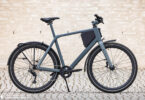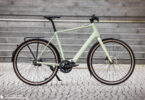Which is the best (E-)cargo bike of 2020? – The 9 most exciting cargo bikes in review
E-cargo bikes inspire a new kind of lifestyle, open up unprecedented new freedoms and are considered a modern status symbol: cool, sporty, sustainable. Not even a Porsche 911 attracts as much interest and positive vibes! We tested nine cargo bike concepts with prices ranging from € 499 to € 7,858 and found a clear winner.
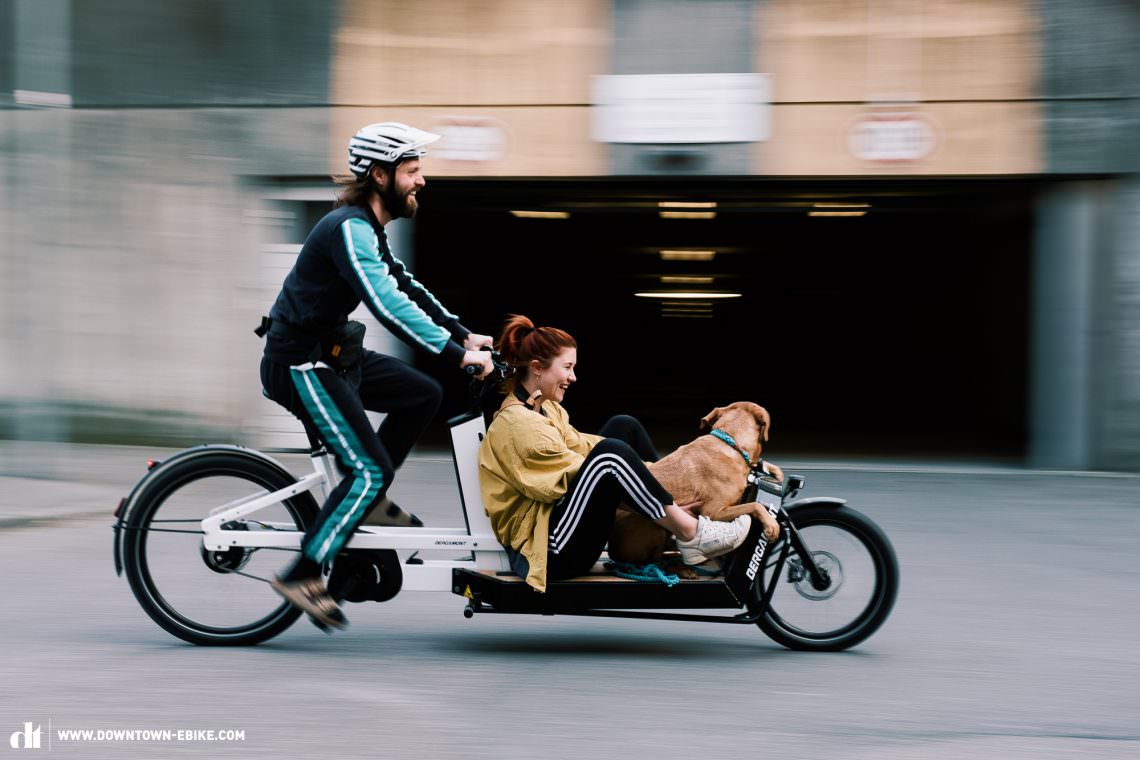
First of all, you do what you feel is right! We aren’t fans of dogmatism, we don’t want to force you to revolutionise mobility or plead for the total abolition of the car. On the contrary, we enjoy hitting the gas on the highway with the company car, transporting goods in the Sprinter or letting our emotions run free as we drive a classic Porsche 911 through the Black Forest and over mountain passes. Idealism is all well and good, but we’re interested in reality. What’s the best solution for our everyday lives? That is why, for most people, we see cargo bikes as an expansion of their mobility and horizons, as a significant improvement to their quality of life and as new status symbols that can even surpass a Porsche or a Rolex – yes, you read that correctly!
This big cargo bike group test is about more than just comparing products. It is about showing you how versatile these bikes are, answering the most important questions and helping you find your way around this rapidly growing market. Because only then can you make the right decision. First, we will present an overview of the category as there is a lot to understand and consider before we introduce you to the individual models. With each cargo bike, we will then clearly explain what it’s good at and the type of riding it is best-suited to. We’ll also tell you what to stay away from.
Table of Contents
- Is an E-cargo bike right for me?
- Which cargo bikes did we test?
- Our cargo test philosophy, our test team and our testing grounds
- What counts on a cargo bike?
- Which is the right cargo bike for me?
- Which is the best E-cargo bike 2020?

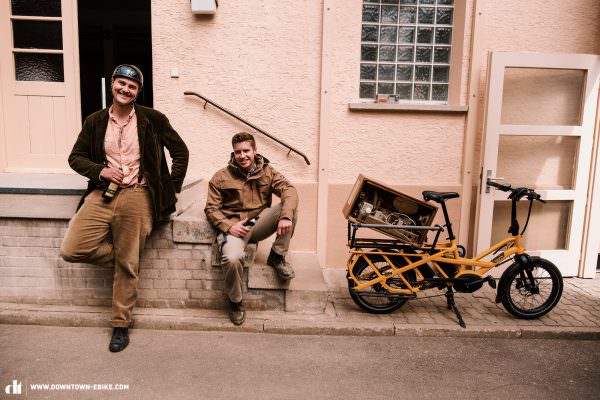
1. Is an E-cargo bike right for me?
E-cargo bikes have the power to improve your quality of life in ways that you can hardly imagine until you try them out yourself. This is why we want you to take part in a small thought experiment, based on real events and experiences during this group test.
Imagine …
- …you never wanted to be famous but suddenly you’re the king.
- …you don’t have to stick to the usual roads on your commute to work and you can spice it up a little with a ride through the forest and along trails! It’s possible with some cargo bikes!
- …you can enjoy that cabriolet feeling, even though you’re not driving a car.
- …your € 6,000 cargo bike gets you more street cred, more positive vibes and more envious looks than the neighbour does with his Ferrari. There’s no better status symbol currently out there!
- …you stop by at our editorial office to try out a cargo bike and you can’t get your kids to climb back out of it. An expensive visit because now you won’t have a choice but to buy one… We’re sorry, Kilian and Erwin!
- …as an early adopter, you and your gang pave the way for a new lifestyle and all your friends come to you to try out and admire your new cargo bike, wanting to find out more!
- …you no longer have to navigate tight parking garages or drive around the block three times to find a parking space.
- …you can get takeaway meals at your favourite Greek restaurant during the corona lockdown and the smell of gyros doesn’t hang around in your car for two weeks afterwards, because you’re riding in the open air.
- …you can take your kids or four-legged friends with you on an adventure when you previously had to leave them at home. The same applies to barbecue parties: all of a sudden you’re the hero for being able to get firewood, crates of beer and, if need be, even the Weber grill to amazing places that you wouldn’t have gotten to by car. Barbecues or picnics outdoors have never been so easy!
- …you don’t need a giant van to live that #vanlife. Go on overnight trips on two wheels instead, with all the luxury you could ever need, including a Persian rug and coffee equipment.
- …you don’t have to worry about where you park your E-cargo bike because it has GPS tracking and comprehensive insurance. Services you would usually only get with a car!
- …cities are quieter because more people are riding cargo bikes and your neighbour no longer roars to work in her fat Mercedes AMG, but glides off on an E-cargo bike instead.
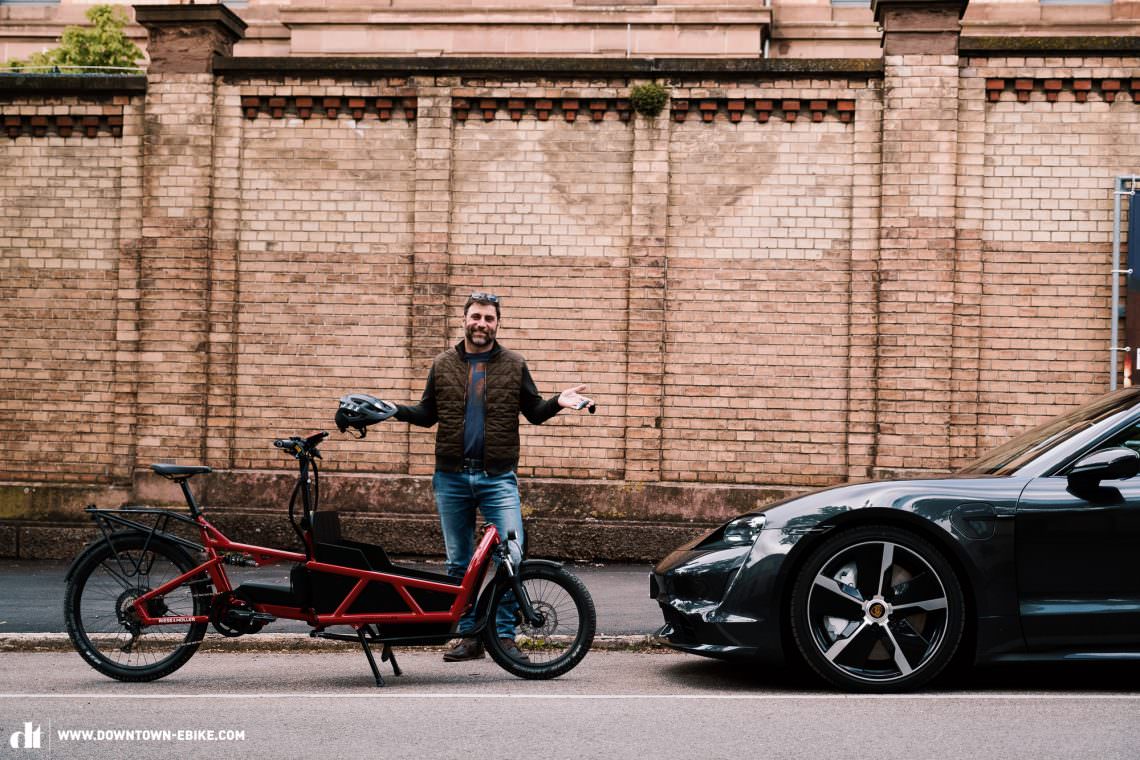
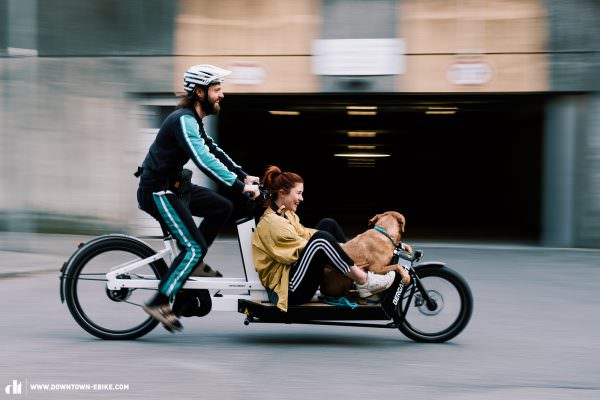


It might just be a thought experiment but, as mentioned before, we’re realists and the fact is that once you have used a cargo bike in everyday life, we’ll no longer have to convince you – you’ll have convinced yourself! You won’t only realise what you’re missing out on but also see the potential that E-cargo bikes have. Because they create a unique lifestyle, open up new freedoms and possibilities and are considered one of the trendiest status symbols in modern cities: sporty, sustainable and conscientious. Not only are they a lot of fun but they’re also faster than any sports car. Not necessarily at the traffic lights, of course, but with an average speed of less than 15 km/h in most city centres, you’ll usually reach your destination quicker with a cargo bike than a car. And sports cars don’t get nearly as many positive vibes and encouragement from delighted passers-by as cargo bikes do. What more could you ask for?
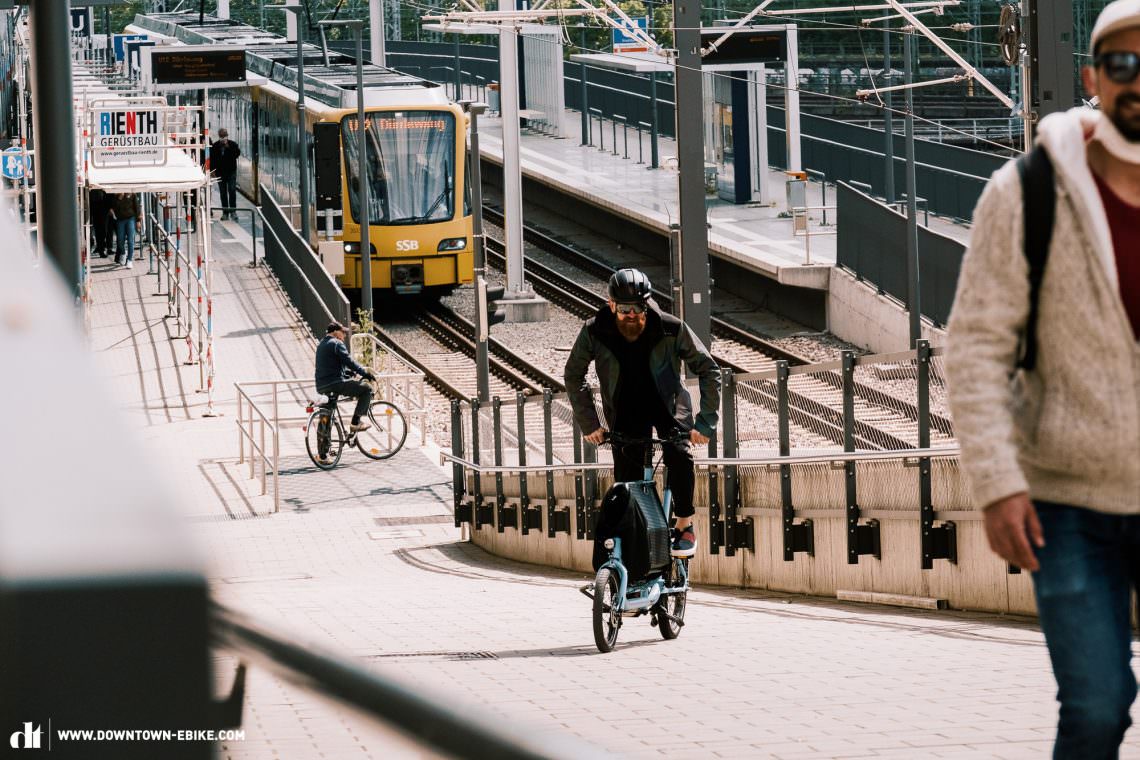
Combinism – cars, the metro and cargo bikes can coexist in harmony
“Revolutionise mobility now! Whatever the cost!” Contemporary green demagogy demonises the combustion engine and the evil industry behind it. The question of guilt seems clear – the car is the root of all evil. But we’d be oversimplifying things if all we did was plead for the abolition of the car and claim that cargo bikes can solve all of our urban mobility problems. You could replace your car with an electrically assisted cargo bike but you don’t have to. Because there are better means of transportation and delivery when it’s cold and wet outside. It is much more important to know what your options are and make the best choice for the right occasion. Do you really have to travel and commute for work at all or will a virtual meeting work just as well in this day and age? Do I have to own a car or could I just join one of numerous car-sharing services? What alternative transport options do I have, including buses, metro, underground and other railway services? If you want to share the cargo bike with your family or friends, who would use it and when? These are questions that we don’t have answers to but that you each have to ask yourselves. If your budget allows, you can use whatever means of transport is most suitable at the time – the best option of all!
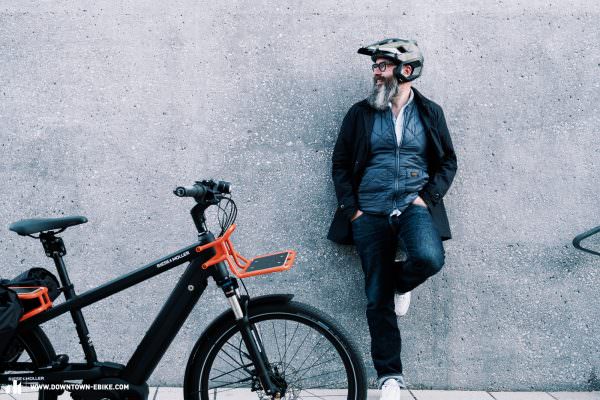

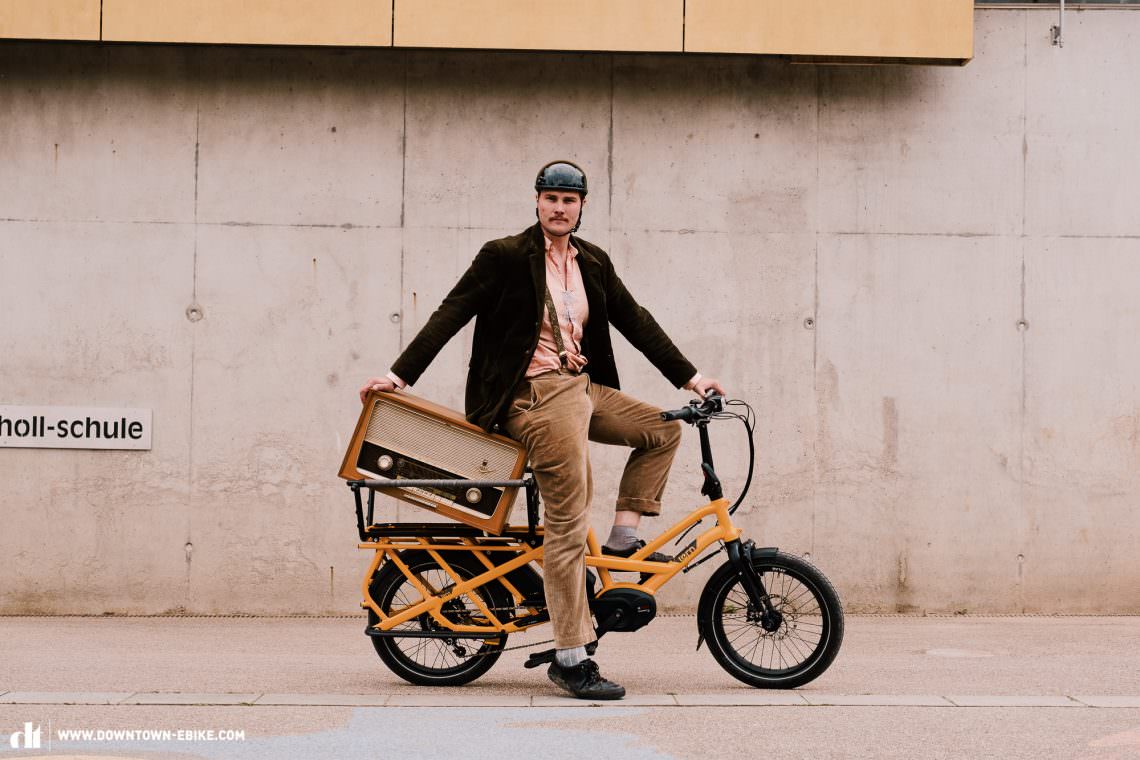
Bring on the prejudices!
Prejudices prevent us from having great moments and embracing valuable experiences. It’s the same with E-cargo bikes. During the course of our cargo bike group test, we encountered a wide variety of opinions and prejudices. Some things were construed as problems when they don’t actually exist at all.
18-wheeler? No thank you!
Even if the long wheelbase suggests otherwise, good cargo bikes don’t handle like trucks and are a lot of fun to ride! While some cargo bikes do have large turning circles, others, like the Muli Muskel, could almost turn on a coaster. Cargo bikes like the Bergamont E-Cargoville LJ 70 carve around corners like you’re on rollerblades. If the weight distribution is balanced, then transporting heavy loads couldn’t be easier thanks to the electric motor!
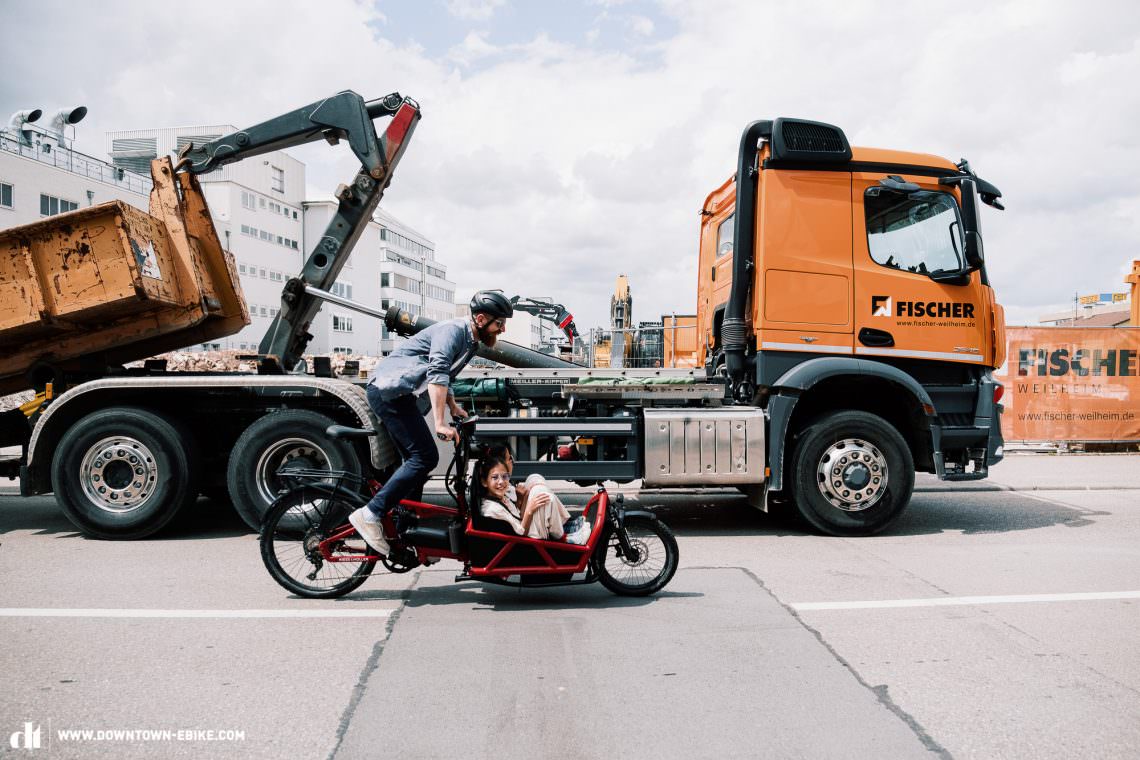
I’ve got nowhere to park it!
Yes, cargo bikes are bigger than normal bikes and, with a few exceptions, can’t be carried down to the basement. But you don’t have to! Due to their dimensions and weight, cargo bikes are less likely to be stolen than a Vespa. If you don’t think you could leave such an expensive item parked on the street, how can so many people leave much more expensive cars or motorcycles out there? So yes, you can own a cargo bike even without a garage or basement. All you have to do is lock the bike up and, if possible, remove the display, batteries and other valuable items. For added peace of mind, you also have the option of trackers such as the RX system from Riese & Müller or the GPS solution from PowUnity, which can be retrofitted on all good ebikes.

E-cargo bikes are expensive!
Sure, compared to the bike you used to ride to college, E-cargo bikes are a serious investment. However, a cargo bike doesn’t only function as a bicycle and you could potentially use it to replace a car. In other words, it’s very important for a good cargo bike not only to be fun but also practical. Smart solutions, (for now) comparatively small production quantities and innovative E-drive concepts ultimately make for a price that seems steep at first glance. However, if you compare the actual costs per kilometre with those of a second car, the price tag is quickly put into perspective. Depending on where you live, many regions and countries also have government incentives in place for E-cargo bikes. The fun you’ll have, the time you’ll save and the stress you’ll avoid by riding an E-cargo is priceless. Further on in this issue, we’ve compiled all the information you need on how to be smart about purchasing a cargo bike and the different e-cargo bike incentives available.
I could never transport as much with a cargo bike as with my car!
Unless you’re running a professional trucking service or have to drive around a family of 7, the carrying capacity of a cargo bike will usually suffice for your day-to-day needs. Besides that, you’ll find many different designs for the loading bay (see next chapter) and lots of different sizes too. Whether you drive a Smart or a 911, there are some things that just won’t fit in your car.
The volume of the trunk is one thing, the actual dimensions and their usability are another. Seeing as it’s in the nature of a cargo bike to be open at the top, you’ll often be able to fit more into it than the trunk of your car.
Some useless facts:
Boot space of a 911: 120 L
Loading volume R&M Load 60 cargo bike: 130 L
Loading volume of a Mercedes Sprinter: 7,800 L
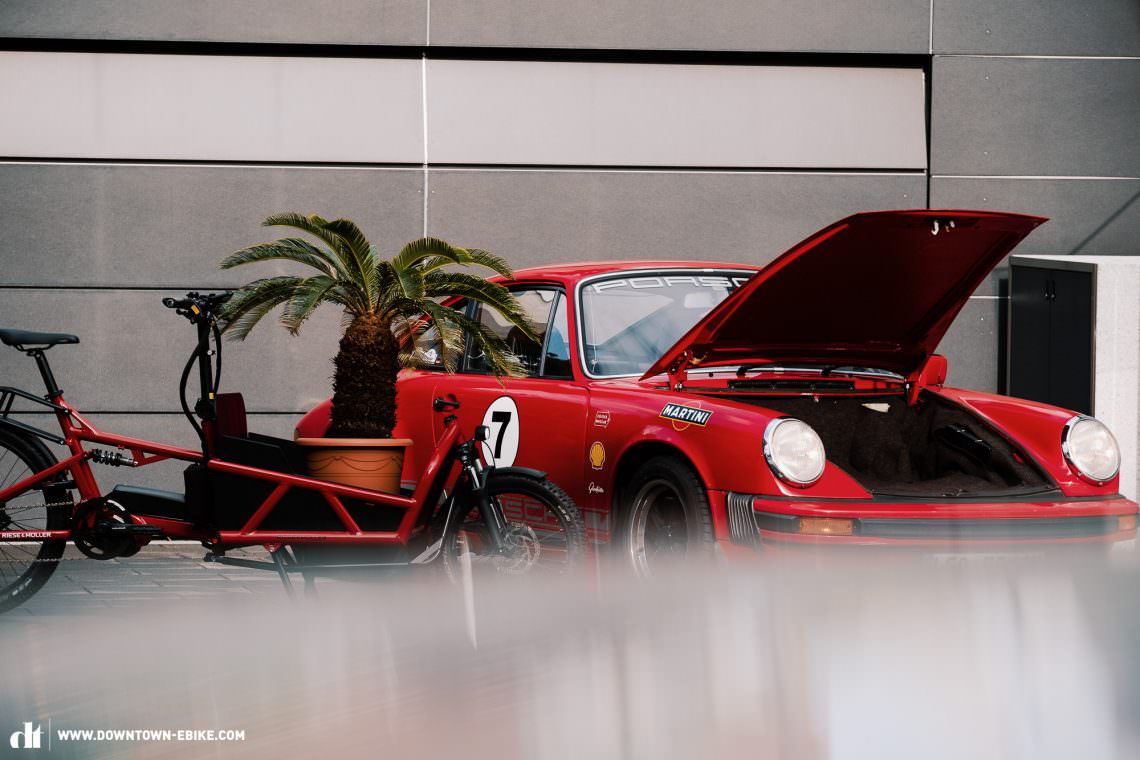
Sounds cool, BUT: I can’t get out of my hamster wheel!
You complain that your days fly by too quickly, your job feels like a hamster wheel and you can’t break out of your routine? Then it is high time to take a step back and get out of the hamster wheel. Remember, it’s the hamster turning the wheel and not the other way around. Sounds simple, right? In theory, it is, but don’t underestimate the power of habit. Try it out, let yourself be inspired and make the cargo bike a part of your new routine by regularly scheduling a ride. At some point you’ll realise that your new routine is no longer a routine – the joy of riding and everyday mobility returns and you discover something new every day
Back to the roots: the big business of cargo bikes!
In the coming years, industry experts see cargo bikes as one of the biggest trends in urban mobility and the bike industry. In 2019, over 75,000 cargo bikes were sold in Germany alone, more than two-thirds of which were equipped with an electric motor. Cargo bikes won’t only change the cityscape and improve the lives of millions of people, but also open up new opportunities for shops and businesses. According to the Moving Europe Forward study done by CycleLogistics, in European cities, around 51% of all motorised transport of up to 200 kg could be done by bike, especially with cargo bikes. By the way: cargo bikes aren’t just the latest trend, they’ve been around for more than a century. When cities weren’t yet overrun by automobiles, cargo bikes, mostly tricycles, were used for a wide range of services, including transportation. With this in mind, let’s get back to those roots!
2. Test field and typology – Which cargo bikes did we test?
Seven E-cargo bikes, one non-motorised cargo bike and one special guest: our cargo bike test field is full of variety that nonetheless lends itself to comparison. There are good reasons for combining such a diverse test field with prices ranging from € 499 to € 7,858. To understand our selection better, we first have to take a quick step back and look at the bigger picture.
What are the different cargo bike concepts?
A cargo bike isn’t just a cargo bike. There are a wide variety of concepts on offer to transport goods as effectively, safely and comfortably as possible. There are three types most suited to consumers. For the professional use that would likely fall outside your remit, you’ll also find heavy-duty cargo bikes with capacities that aren’t conducive to everyday practicality, as well as trailers such as the CARLA CARGO or BicyLift Trailer from FlexiModal – you’d even be able to transport a cargo bike itself. 😉
There are big differences between the various types of cargo bikes in terms of their centre of gravity, stability, usability and how easy they are to load things onto. Depending on the design, some models are more versatile than others, with handling that either improves or worsens when hauling cargo. Cargo bikes may share some commonalities but, ultimately, it all depends on the manufacturer’s design and how they have implemented the complete concept. It is for this reason that we recommend reading our individual reviews for an in-depth analysis of each cargo bike’s specific strengths and weaknesses.
Long john
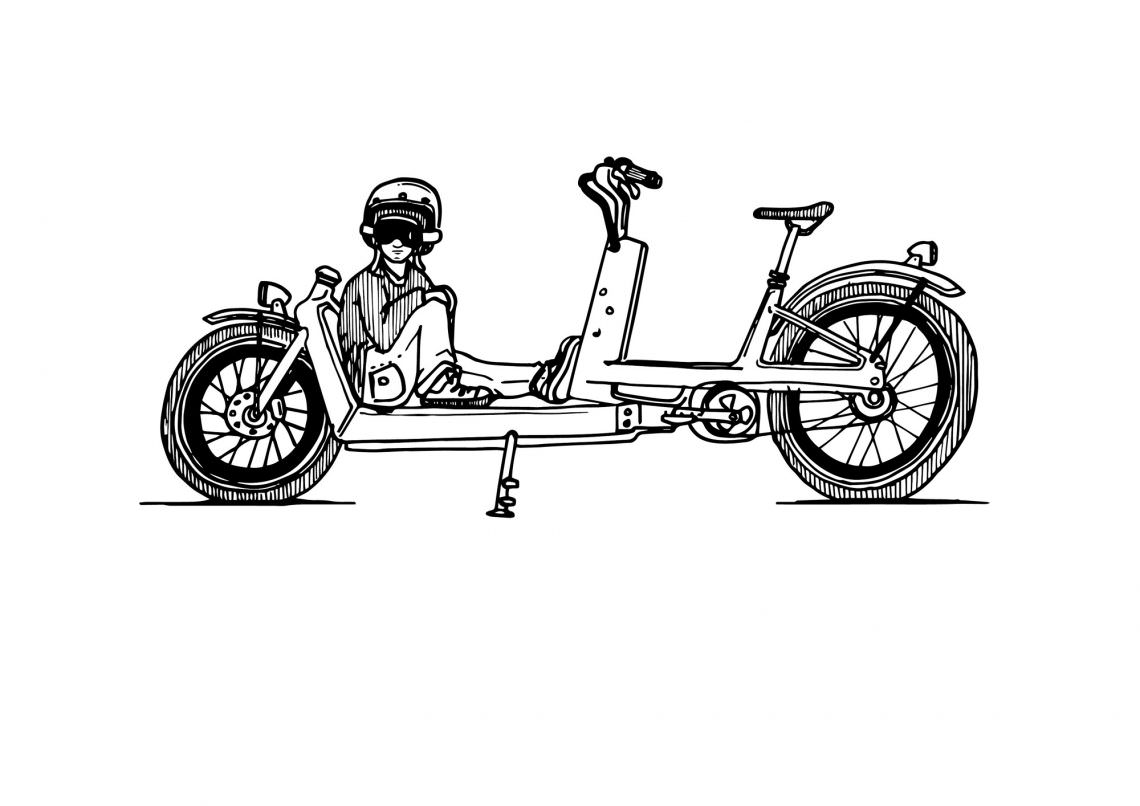
Long john cargo bikes have their loading bay in front of the rider, in the space between the bars and the stretched out front wheel. This way, you can always keep an eye on everything you’re hauling. Depending on the frame, this design keeps the centre of gravity quite low between the two wheels allowing you to ride these bikes quite dynamically. That results in a more enjoyable ride and also makes sense in narrow streets. There are huge differences from one model to the other regarding turning circle, agility and handling stability. Some long john bikes, like the Muli, even have a foldable loading bay, which can help save on a significant amount of space when you park and be significantly narrower when riding without cargo. Always use the stand when parking. If you plan on frequently transporting heavy loads and want to avoid putting your back out, it makes sense to use a long john bike with a low loading bay.
Longtail/Backpacker/Baker’s bike
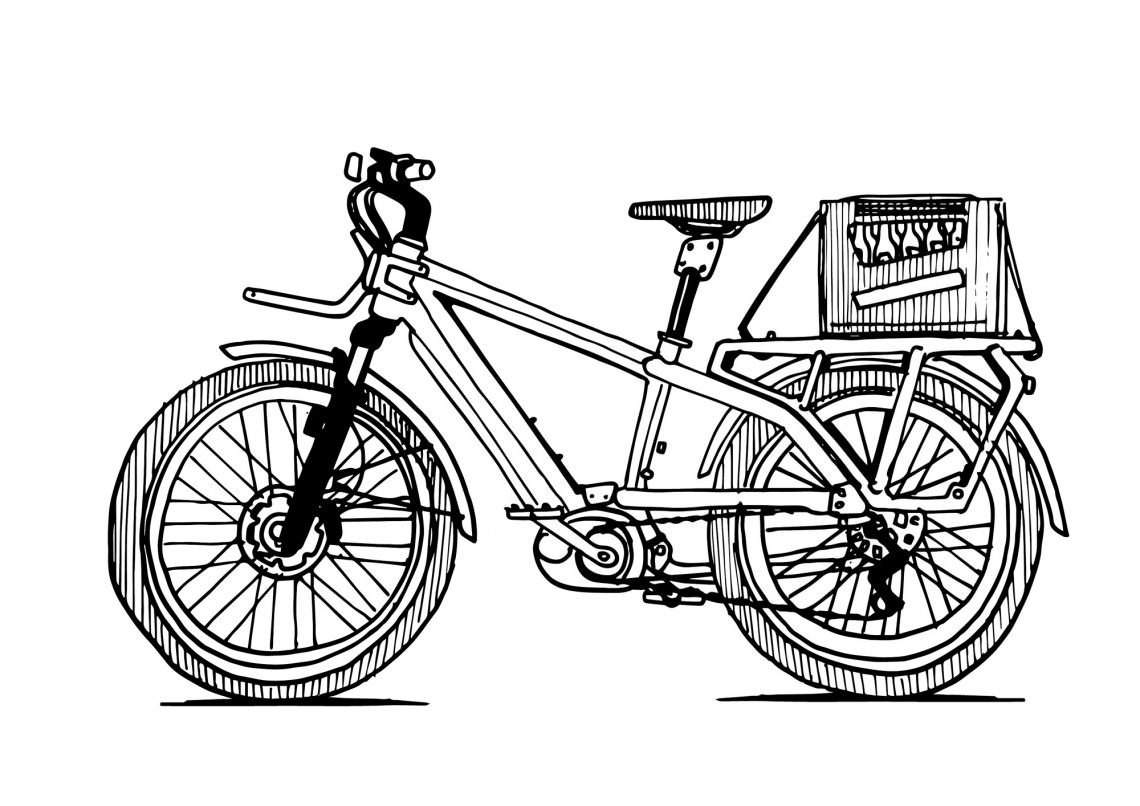
Grab your backpack and go explore the world! Longtail, backpacker and baker bikes come the closest to conventional bikes in terms of their riding position, handling and turning circle. They are just as easy to ride and usually quite agile. They typically have an extended rear end with an extra-large luggage rack, providing space for up to three kids or cargo, the position of which gives the bike stable handling. You’ll usually find features such as modular child seats, with footrests and handles. The secret weapon of longtails and backpackers are their large pannier bags with plenty of storage space for big shopping sprees. A front rack, which is available as an option on most longtail or backpacker cargo bikes, turns them into so-called baker’s bikes because bakers used to do the rounds delivering baked goods on the stable front rack. Maybe these days they should be called Uber Eats bikes?
Tricycle/Trike
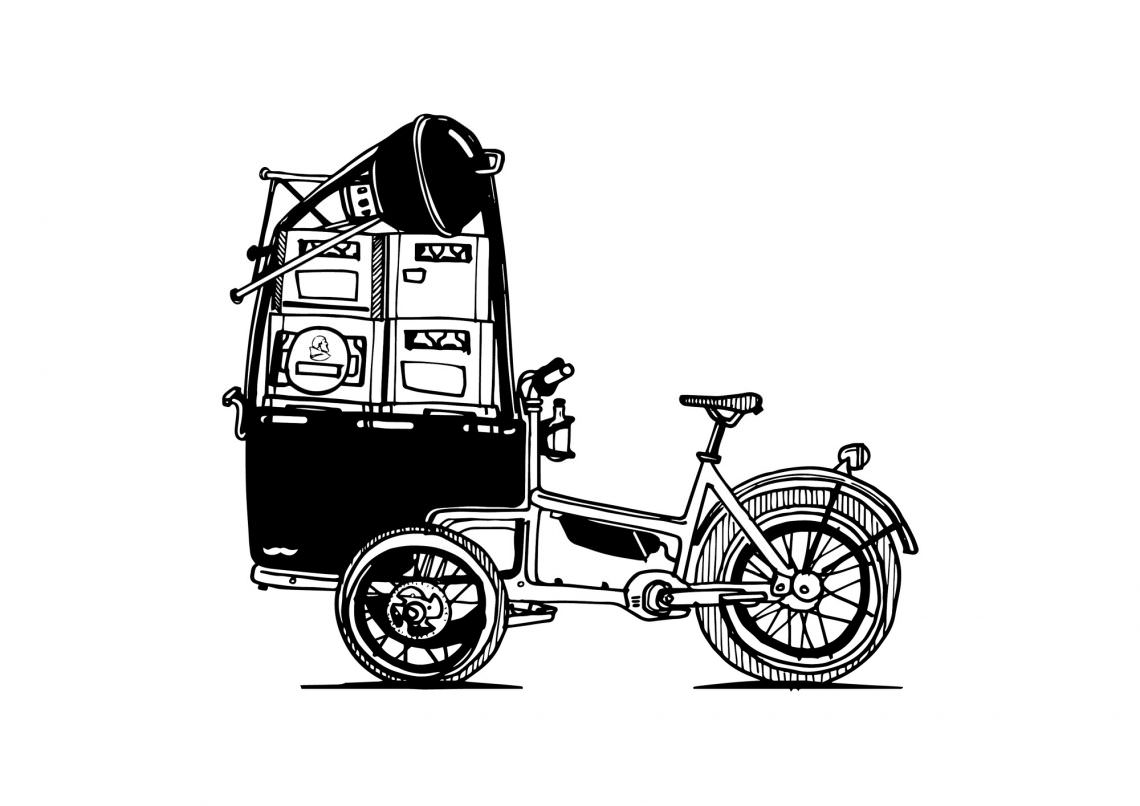
There are two types of tricycles, also known as cargo trikes, with either the transport box between the two front wheels or the two rear wheels. In theory, three-wheeled cargo trikes are easy to ride because you don’t have to balance the weight as you do with two-wheeled cargo bikes, though this only really applies as long as you ride in a straight line. As soon as the dynamics of cornering and multidirectional forces come into play, things become a lot more complicated. In practice, tricycles often feel nervous, offer poor leverage and unfavourable weight distribution. It’s very possible to overturn a tricycle or quickly reach a critical point, particularly when riding fast. This is also dependent on the type of steering and the tricycle’s chassis, which both have a big influence on handling. There are two main types of steering: an articulated axle where the cargo box and axle move with the steering, or Ackermann steering like you’ll find on a car, where the front wheels each turn on their own axle and are therefore able to trace out circles of different radii, which change depending on the steering angle. Some bikes, like the Butchers & Bicycles Mk1-E, combine Ackermann steering with a leaning mechanism to compensate for the shift in forces as you corner and height differences in the road – it’s cleverly designed but the concept often has limitations in practice. It’s crucial to take these types of bikes for a test ride in real-world conditions, loaded up, to see how they handle!
Trailers

Not strictly a cargo bike, but trailers are another hauling option and proof that you don’t always need a classic cargo bike. This is the most affordable option for everyone that already owns an ebike that’s certified to pull a trailer. Though it’s often the most sensible solution, admittedly a trailer doesn’t come close to the modern image and fun experience of riding a long john. Depending on the model and how it gets mounted to the bike, a trailer can change the handling of your bike quite significantly. However, the great thing about trailers is that they turn your regular bike into a cargo bike, giving you lots of flexibility and negating the need to buy a new bike, making them the most affordable option! The market offers single and double-wheeled models with and without suspension. You’ll find everything from trailers designed specifically for dogs to heavy-duty workhorses or child trailers that easily convert into a pram.
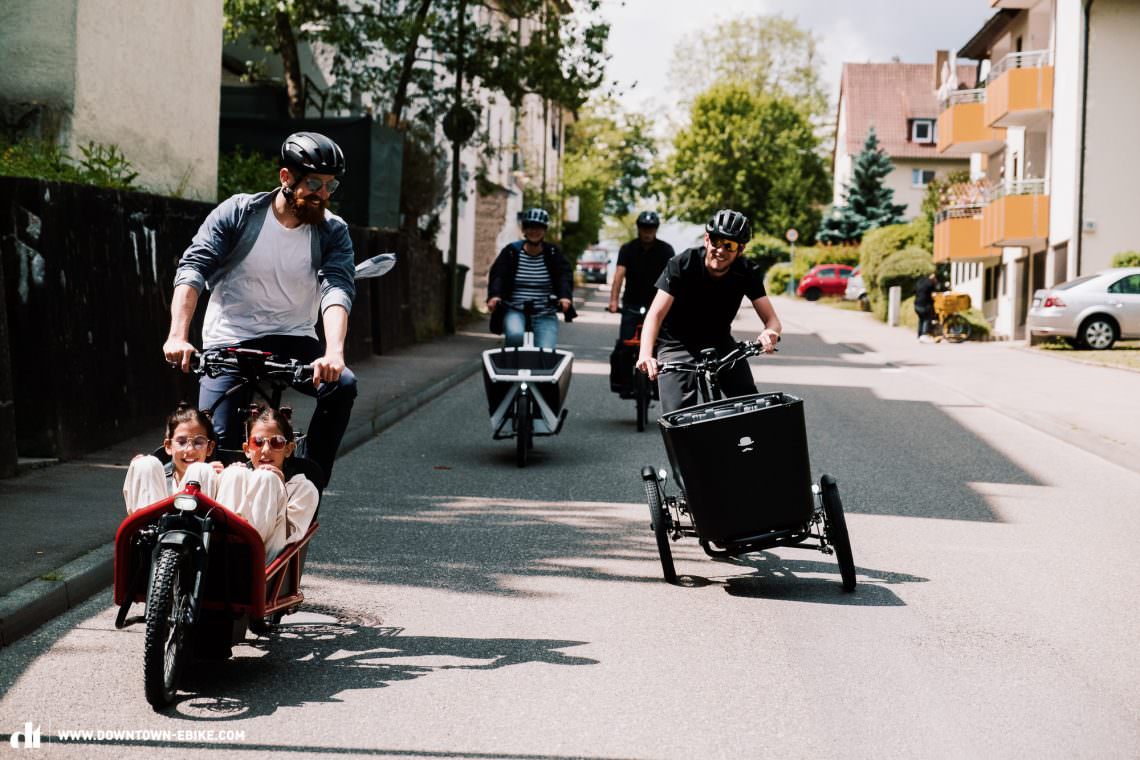



Our cargo bike test field
For this cargo bike group test, we put our primary focus on E-cargo bikes. Even if you live in Amsterdam or elsewhere with no hills in sight, everyone can benefit from the support of a good electric motor, making riding easier and more fun, which in turn means you’ll use your E-cargo bike more often while being able to ride faster and further. We selected seven of the most promising E-cargo bikes currently on the market. To be able to investigate different areas of application, specific features and all cargo options out there, we also included the Croozer cargo trailer and the non-motorised, super-compact Muli Muskel in the test field to complete the picture.
| Bike | Price as tested | Weoght | Motor | Battery |
|---|---|---|---|---|
| Bergamont E-Cargoville LJ 70 (Click for review) |
€ 5,399 | 45.9 kg | Bosch Cargo Line Cruise | 625 Wh |
| Butchers & Bicycles Mk1-E Automatic (Click for review) |
€ 7,626 (from € 6,699) |
51.3 kg | Bosch Performance Line CX*** | 500 Wh |
| Croozer Cargo Tuure (Click for review) |
€ 499 | 10.6 kg | – | – |
| Larry vs Harry STePS eBullitt E8000 XT Di2 (Click for review) |
€ 6,336 (from € 5,125) |
36.6 kg | Shimano STEPS E8000 | 1,008Wh* |
| Muli-Cycles Muli Muskel (Click for review) |
€ 3,045 (from € 2,725) |
27.4 kg | – | – |
| Riese & Müller Load 60 Touring GX (Click for review) |
€ 7,858 (from € 5,999) |
45.5 kg | Bosch Cargo Line Cruise | 1,000 Wh* |
| Riese & Müller Multicharger GT Vario (Click for review) |
€ 5,008 (from € 4,699) |
38.2 kg | Bosch Performance Line CX | 500 Wh |
| Tern GSD S00 (Click for review) |
€ 6,082 (from € 4,999) |
42.8 kg | Bosch Performance Line CX*** | 1,000 Wh* |
| Urban Arrow Family Performance CX Disc Zee 500 Wh (Click for review) |
€ 5,390 € | 52.0 kg | Bosch Performance Line CX*** | 500 Wh |
| Ø € 5,908** | Ø 42.5 kg** |
*dual battery **without Croozer trailer ***predecessor model
Why are the cargo bikes in this test field so expensive?
Because we want to prevent you from having to buy twice… Of course you’ll be able to find cheaper E-cargo bikes but we’d advise you to proceed with caution. Even at an average price of around € 6,000, some of the high-quality cargo bikes we tested still have weak points that could be improved. With cheaper bikes, you’ll inevitably run into a lot more issues. Quality simply costs a bit more and especially in terms of durability, reliability and after-sales service, motors from Bosch or Shimano are miles better than unidentifiable no-name products.
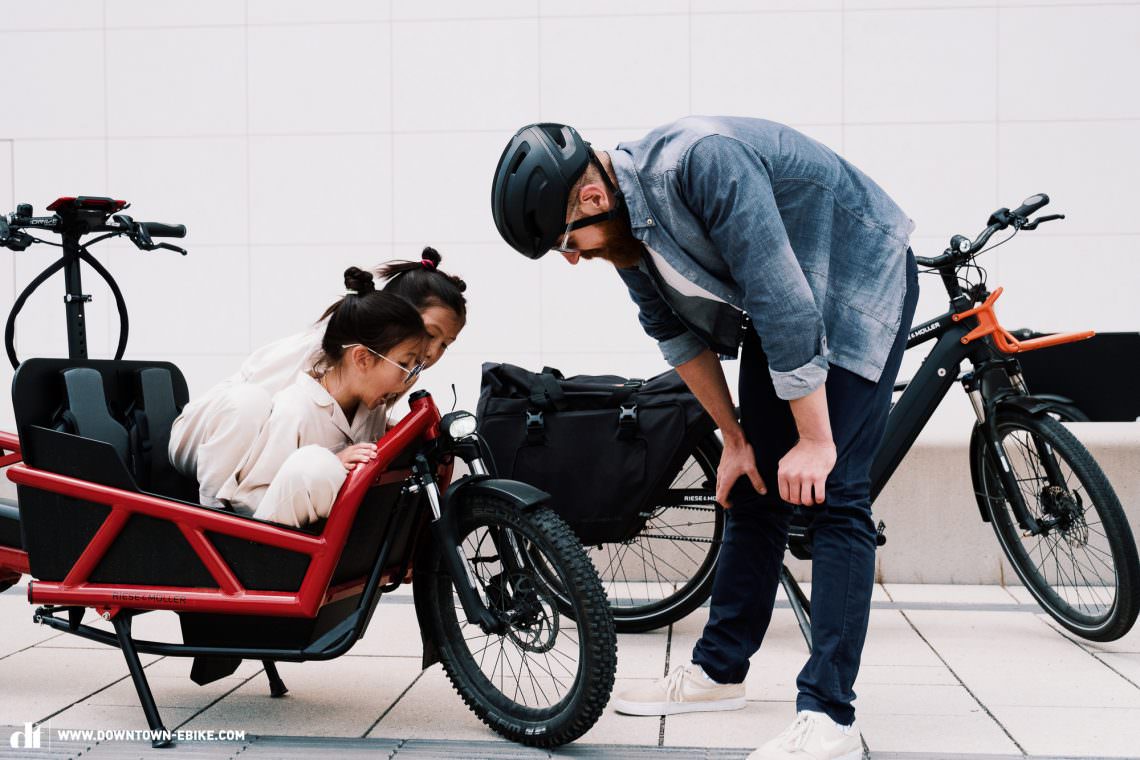
3. Important things to understand – Our cargo test philosophy, our test team and our testing grounds for the hottest cargo bike of 2020
Originally, cargo bikes used to be reserved for flat terrain. After all, who wants to haul a heavy load up a hill purely with the power of their legs? However, the use of electric motors has opened up a lot more possibilities, turning new regions into true cargo bike metropoles.
We chose one of the most demanding regions that you could think of as our test location: our home, the automotive metropolis of Stuttgart, also the home of industrial giants like Bosch, Mahle, Mercedes-Benz and Porsche. We didn’t just navigate our way through heavy traffic, busy central hubs and narrow streets but also ventured into the outskirts, like Leonberg (where our head office is located) and Ludwigsburg, where cobblestones and off-road passages tested our joints. Stuttgart also has some of the toughest topography with the type of steep climbs you might otherwise find in places like Lisbon or San Francisco. It quickly became clear that whichever bikes survive our tests won’t have any problems in flatter cities like Berlin, Amsterdam or Copenhagen.

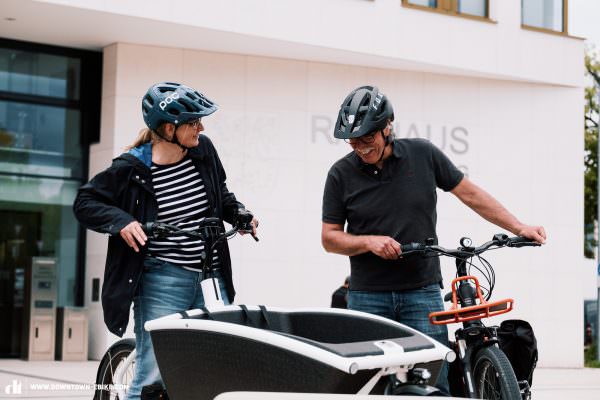
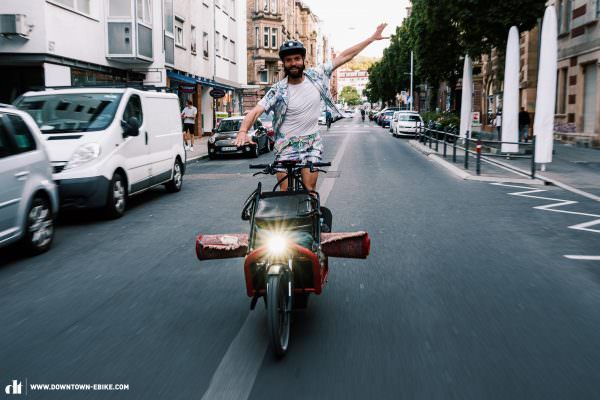
Anyone who knows us knows that we don’t do things by half measures. We spared no effort for this cargo bike group test and brought in the skills of all our magazines including E-MOUNTAINBIKE, GRAN FONDO and ENDURO to tap into the team’s substantial and collective knowledge about electric motors, battery technology, connectivity, chassis construction and design. We combined the professional testing competence of editors, engineers and test riders, some of whom review over 100 different bikes each year, with the inexperience of beginners and people of all ages who had never ridden a cargo bike. Once again, we invited our friends and families to take part, from a dentist to 10-year-old twins, 70-year-old grandparents and young parents with babies. Even our dogs had to serve as test riders. It was a fair amount of effort, but it would be a lie if we said we didn’t have fun doing it! On the contrary, everything we learned during this test was worth the effort we put into it.

Putting in the distance at the 25 km/h motor assistance limit while riding along the Neckar river was just as important as maximum payload tests, cargo volume experiments, overnight trips with a Persian carpet and handling stability with slightly drunk test riders *clears throat* on a closed test circuit, of course. For style tests, to see which bike got the most attention and positive vibes, we took them to dinner in places where the cars park in front of the door and people primarily go to see and be seen. Guess who won.
Test rider testimonials

Shopping in the city, adventuring and commuting: for me, an E-cargo bike is better than a car. You don’t have the traffic jams and stress and you don’t have to look for a parking spot. Since I don’t have a garage, I need the right anti-theft device to be able to sleep at night, which means I need a lock and GPS tracker. PowUnity offers aftermarket options but the RX-Connect package from R&M with the GPS tracker, insurance and replacement service is next level!

From 0 to 100 in 3.2 seconds, the handling of my new Taycan Turbo is incredible and it’s brilliant fun to drive. However, cargo bikes are too and both offer a unique experience. It is unbelievable how many people approach you about these bikes, which usually leads to very pleasant, random conversations and makes people open up.

design without function is no fun! The Butchers & Bicycles had me at hello but the nervous handling and the unbalanced weight distribution quickly sobered me up. If it doesn’t feel stable, then I won’t get on the bike.
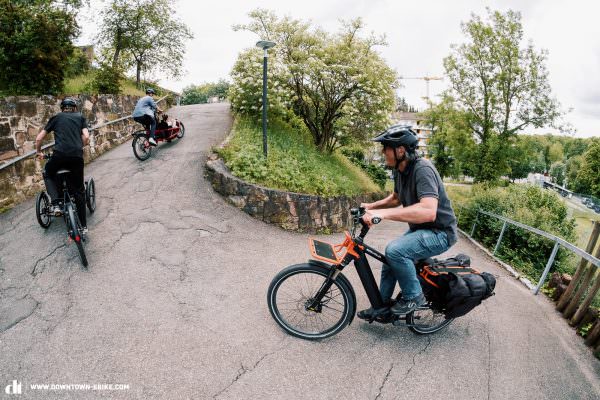
The handling of the Riese & Müller Load 60 feels incredibly secure. I can’t get my kids to climb out of it. Now I have to buy a cargo bike and let the T5 collect dust in the garage! To be able to afford it, I guess I’ll have to put in a few double shifts pulling teeth!

Dog today, beer crate and camping equipment tomorrow and possibly transporting the kids in the future? Good cargo bikes mix up your routine, adding a bit of fun to your life while opening up new perspectives. I only have two vehicles in my life: a cargo bike and an original Porsche 911, which I think is the best combination!
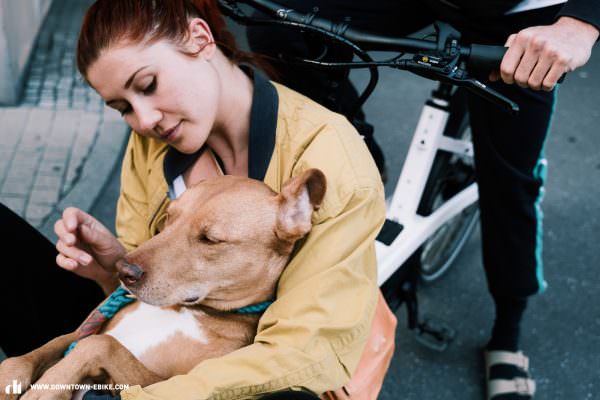
To me, a cargo bike without an electric motor is not a cargo bike! Why exert so much effort when there’s an easier, more comfortable way!? To me, the keys to cargo happiness are style, safety and relaxation. The Bergamont E-Cargoville LJ 70 is my clear favourite.
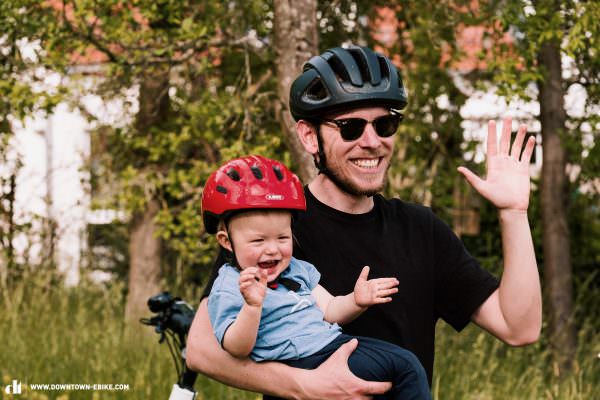
I love riding aggressively and even if the eBullitt is brutally uncomfortable, the roadie in me loves its direct and stiff handling. I don’t recommend using it to ride down curbs or transport kids. For experts only!

With my build, I’m probably the cargo bike’s biggest load! That’s why it’s important to me that the cargo bike is able to carry my weight. I also want to use it to cruise through the city and have random fun. Practicality and versatility are essential if I spontaneously decide to take something with me or load my bike up with beer and a boom box: everything you need for a good day.

I never go anywhere without my dog. Of course, cargo bikes are great for everyday life, but for me, my eMTB and a trailer do the trick! There’s enough space in the trailer for our Labradoodle Henry as well as a few small items!

A cargo bike is ideal for trips to the lake. There’s more than enough space for a picnic blanket, towels, food and, depending on your mood, a stand-up paddleboard. The best thing about it is that you don’t have to rely on finding a parking space and you can ride right up to the shore. That’s real luxury. With all that luggage and 50 km to cover, I feel safer with a dual battery.

If you ask me, an E-cargo bike has to be off-road capable and have a navigation system. Accordingly, the Riese & Müller Load 60 with its off-road tires and SmartphoneHub is the obvious choice.

Call me a tech freak! I deal with the latest electric motors, suspension kinematics and connectivity features on a daily basis. The power, control and dynamic range of the new Bosch Cargo Line motor sets the standard. I was disappointed to see many of the current cargo bikes specced with 6-year-old motors.

A quick espresso at dawn and off to work – I’ve increasingly started choosing the cargo bike over my van. I need good lights on my bike for early morning commutes or late nights in the studio. With 50 kg of photography equipment in tow, I also need a generously sized cargo bay and powerful motor. That way I can easily use the cargo bike for local jobs and it’s a great conversation starter with my clients!

Dadada, dididididii…Ohhhhhh… Mammma!


When deciding which option best suits you, you should think about your personal requirements and the primary purpose of your cargo bike. The design, componentry, accessories and handling of a cargo bike are just as important its functionality. For this reason, we deliberately kept the test field very broad and don’t award points or grades as other magazines do. Instead, we highlight the specific strengths and weaknesses of every bike or trailer and show what the different models excel at and what they don’t. We also tell you what to look for and provide tuning tips for each model.
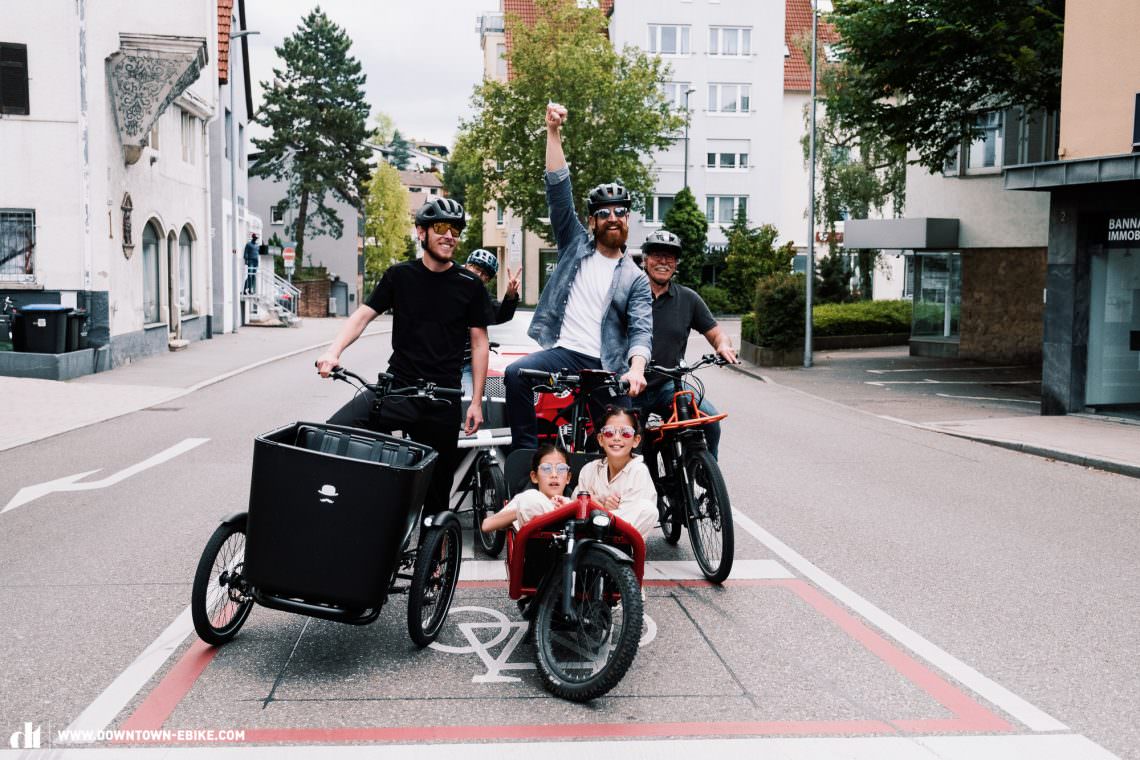
4. What counts on a cargo bike? 10 things to look for on a cargo bike!
E-cargo bikes are used in a wide variety of ways and so they have to meet a variety of individual requirements. Nevertheless, there are some very important features, functions and components that apply to all of them and that you should pay attention to. We’ve compiled a list of the 10 most important!

1. Don’t let yourself be blinded, these are things cargo bikes do NOT need!
Design before function: Of course, as with a car, the brand image, look and associated emotions often play a decisive role, but if you want to be happy in the long run, your bike shouldn’t be uncomfortable, cumbersome or unnecessarily exhausting to ride. Some models are great to look at, but they lack the performance and handling to back that up. You don’t buy a cargo bike to have it standing in your garage or living room but to use it and have fun! That said, we have to admit that we have heard of people who bring their cargo bikes indoors because they’re cool and they can!
Wow, have you seen that E-cargo bike for € 3,000? Caution, if you buy cheap, you buy twice and the same applies to cargo bikes. A sturdy and functional frame, robust and reliable components and, above all, a powerful mid-motor simply are going to cost money. Of course, you could buy a cheap knockoff but then you’ll have to accept frequently recurring problems. Add in significantly poorer handling, comfort and fun and you have to ask yourself if it’s really worth it. For a good E-cargo bike, you have to budget at least € 5,500.
Not for weight weenies! Apart from DOWNTOWN editor-in-chief Ben and test rider Benedict, we don’t know anyone who would wheelie a cargo bike. They tend to be too heavy! Chances are that you won’t be able to carry your cargo bike up or down any stairs. There was only one bike in the test field that you could store in your basement. But either way, it’s not the weight of the bike itself that’s important for an E-cargo bike but the weight distribution. “How stable is the cargo bike’s handling when carrying a load?” is a much more important question than, “How light is it?” It all comes down to the design of the frame since the wheelbase, the centre of gravity and type of construction play a critical role in determining how easily you can manoeuvre and park a cargo bike.

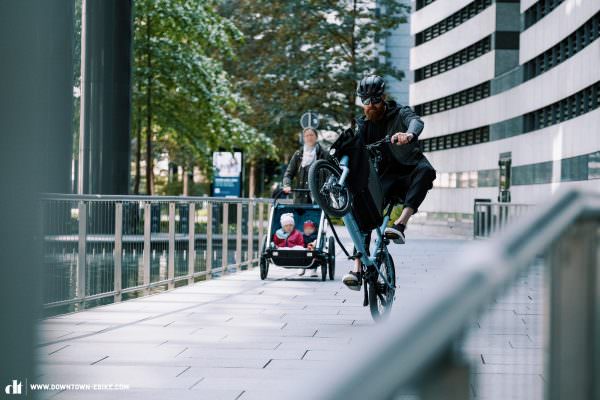
2. Cargo bike safety
We consider safety to be one of the most important features of cargo bikes. This includes:
- predictable and intuitive handling with and without a load
- grippy tires in wet and dry conditions on asphalt and loose surfaces such as gravel
- powerful and reliable brakes that are easy to modulate, especially when riding in hilly terrain, transporting heavier loads or stopping quickly in city traffic. We definitely recommend four-piston disc brakes with at least 180 mm or 200 mm rotors, depending on the topography.
- to see and be seen in road traffic with powerful and sensibly positioned front and rear lights that don’t get covered up when carrying a load. Lights with a high and low beam function are the best!
- full-suspension or at least a suspension fork, which smooths out the ride for fragile cargo as well as kids, offering more control on poor surfaces or even when hitting a curb. There aren’t many cargo bikes currently on the market that offer this.
- adjustable steering resistance. Depending on the design, this isn’t always necessary, but steering dampers are generally effective at preventing speed wobble or nervous handling. You’ll often find a similar feature on motorbikes.
Cargo bike safety can’t just be determined by the individual components. You have to look at the whole package and understand how all the individual parts interact while riding to truly understand how well the system works.
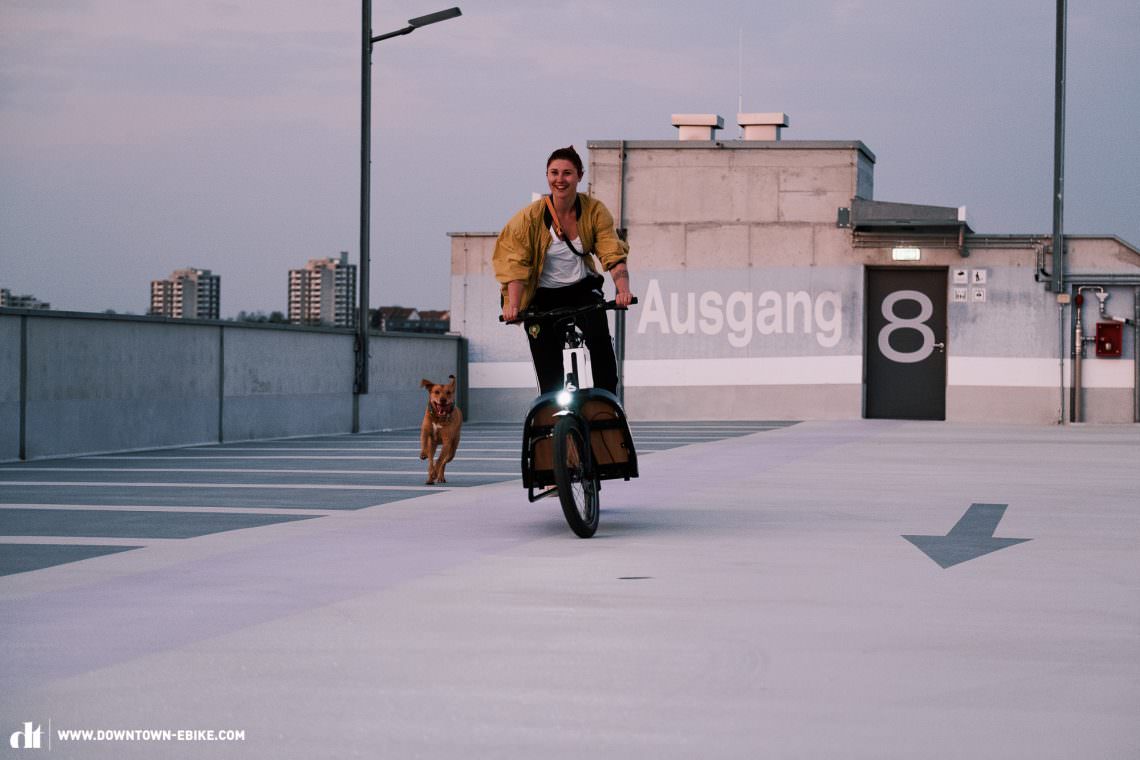

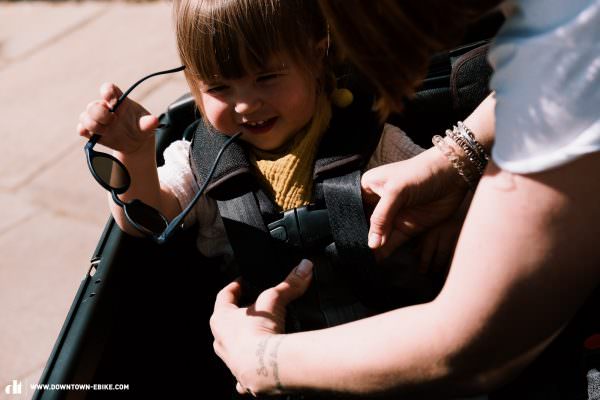
3. Cargo bike comfort and ergonomics
We know, ergonomics and comfort aren’t the coolest topics but even if you’re in the prime of your life it’s something that everyone should pay attention to. An ergonomic riding position not only makes riding more fun, efficient and carefree but it also gives you a more assertive position to see what’s happening around you and ensures you have better control.
Ergonomic considerations also include an easy mount and dismount: are your kids in danger of getting a roundhouse kick to the face when you get on the bike or is there a low step-through section that allows you to get on without having to lift your leg over the bike? A slack seat tube angle can also help get your feet on the ground without having to get off the saddle when you come to a stop. Dropper seat posts make getting on and off the bike a lot easier too. You can even get remotely operated dropper posts with integrated suspension, which work well and provide additional comfort, though unfortunately, they didn’t feature on any of the bikes in the group test.
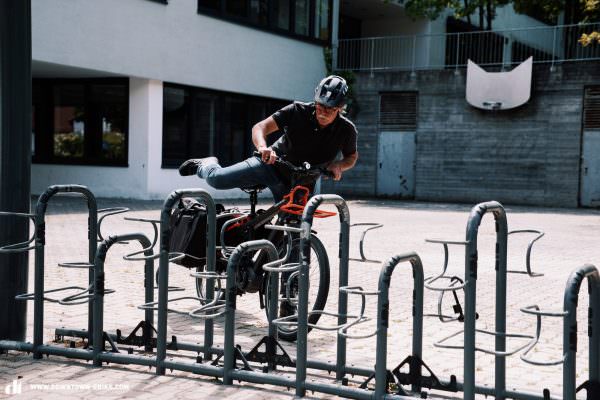
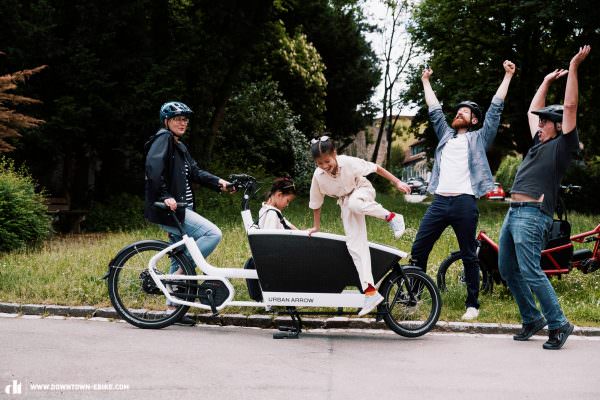
Depending on the type of rider, everyone will be looking for something unique to their needs. Some want an aggressive riding position with direct handling, like the eBullitt provides, ideally combined with optimal power transfer. Others prefer that Dutch bike feeling for more relaxed cruising, such as on the Urban Arrow. Of course, a full-suspension chassis like that of the Riese & Müller Load offers unbeatable comfort while the premium German brand’s GX model even comes with knobbly off-road tires for more control and traction in poor conditions. If you don’t have suspension (and even if you do), large-volume tires are able to work wonders for comfort and traction.
In principle, adjustable cockpits are an excellent idea for quickly dialling in the rider’s position, especially if several people share the same bike. However, adjustable stems often tend to be wobbly and less stiff and precise than their non-adjustable counterparts. Make sure to try before you buy.
Contact points such as the grips, pedals and especially the saddle are crucial in determining the overall comfort of the cargo bike and, moreover, they’re the easiest to replace. However, as they’re so subject to personal preference, evaluating these isn’t relevant to our test.
4. Cargo bike with or without a motor?
There aren’t many reasons not to have an electric motor on a cargo bike unless you enjoy suffering! Numerous studies have shown that ebikes get used more frequently and for longer than purely muscle-powered bikes. It is important to understand that all E-support isn’t equal and that there are two types of ebike: pedelecs and s-pedelecs. By law, pedelecs support the rider up to a threshold of 25 km/h in Europe and up to 32 km/h in North America and are legally classed as regular bicycles, giving them the same rights and obligations.
E-cargo bikes classified as s-pedelecs offer support up to a speed limit of 45 km/h, which is great if you usually cover longer distances and are seriously considering using a cargo bike as a replacement for your car. However, you should note that s-pedelecs aren’t allowed to ride everywhere, require you to wear a helmet and need a registration plate. As they are classified as mopeds, you’ll also need the relevant driving license (which is included in every class B car driver’s license in Europe). Remember, speed limits and legal classifications may vary from country to country.

5. What is the best electric motor for cargo bikes?
All of the E-cargo bikes we tested come equipped with proven mid-motors from the eMTB bike sector, offering the performance and durability you’d expect. The Bergamont E-CARGOVILLE LJ 70 and Riese & Müller Load 60 both feature the latest 2020 Bosch Cargo Line motor, the software of which recently got an update specifically tuned to the differences between a fully loaded and an empty bike as well as different riding styles. We were the first magazine worldwide to put this latest software update to the test. The eBullitt is the only bike on test equipped with Shimano’s STEPS E8000 motor while the rest rely on the old generation Bosch Performance CX, which has been tried and tested over many years.
Of course, there are a lot of other electric mid-motors, as well as front or rear hub motors on the market, which you’ll find on cheaper E-cargo bikes. However, these tend to overheat on longer climbs, offer little torque and are generally subpar in terms of control and performance. They may work reasonably well on flat terrain, but they would quickly get overwhelmed in places like Stuttgart or San Francisco.
The best cargo bike motor should be very powerful, yet offer easy control of that power while supporting a wide range of pedalling cadences which is essential when setting off, when you’ve accidentally selected the wrong gear and on steep climbs. The motor, cadence and gear range all have to suit each other to deliver optimal performance. When riding in hilly terrain the motor could stall and in the worst case, you’ll have to push! It’s equally important that the motor is able to dynamically adapt to different situations, with and without a load. This is why all the motors we tested have several different support modes, allowing you to adjust the handling of the motor to suit your current needs.
A progressive support mode such as Shimano’s Trail mode or the Bosch eMTB mode dynamically adjusts power output to suit the situation you find yourself in without having to constantly switch between modes.
Making the best impression by far is the Bosch Cargo Line motor, which is based on the Bosch Performance CX but has been adapted to the specific demands and requirements of cargo bikes. Delivering 400% support, it quadruples the rider’s effort. The cargo bikes specced with the Performance CX motor still rely on the previous CX generation, which only offers up to 300% support and also has some other disadvantages in terms of performance, noise and ride feel above the 25 km/h threshold. Since releasing a free software update in July 2020, the torque output of Bosch Cargo Line motor has gone up to 85 Nm (previously 75 Nm) and its assistance modes have been further refined. With these specs, it leads the charge when fully loaded and on steep climbs and it easily leaves the competition behind in terms of performance and ride feel!
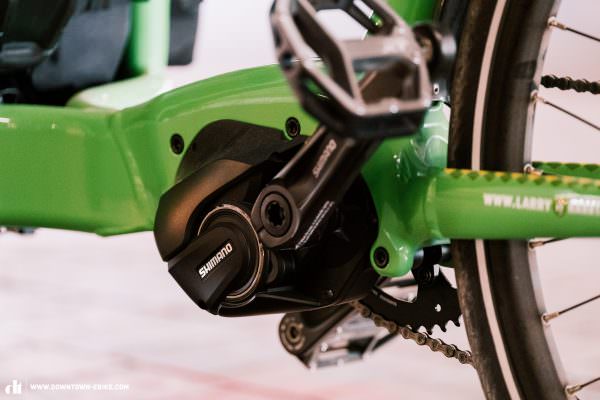
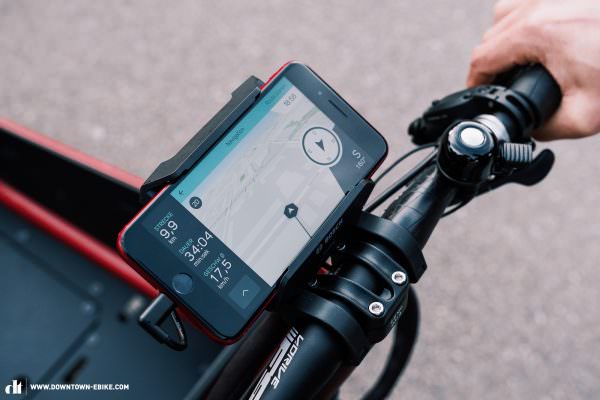
Key terms that you should know before buying:
Battery capacity
The battery capacity is indicated in watt-hours (Wh). Depending on the cargo bike, it varies from 500 Wh to over 1,000 Wh and you can think of it as the size of your fuel tank. How far you can ride on a full charge depends heavily on the ‘consumption’ of your motor, your riding style and around 20 other variables.
Power output
On an ebike, the motor’s power output is specified in watts. Legally, the nominal power of pedelecs is limited to 250 W. Nevertheless, all motors achieve a much higher peak output, resulting in clear performance differences between models despite the same nominal output.
Torque
Torque is measured in newton-metres (Nm) and describes the force with which a motor supports the rider when pedalling. The higher the torque, the more powerful the assistance. You’ll feel a difference in torque most noticeably at slower cadences, such as when you’re pulling away, have selected a gear that is too high or on steep climbs and when the cargo bike is fully loaded.
Gear range
The gear range of the drivetrain is measured in percentage. The larger the gear range, the greater the difference between the smallest and the largest gear. Depending on the topography, you’ll want a range of at least 400% to be able to pedal at a suitable cadence, when riding uphill or on level terrain, for the motor to be able to unleash its full power.
Derating
If the motor or battery threatens to overheat, it reduces its output as a self-protective measure. This can happen if you’re in the wrong gear, carrying a heavy load or pedalling up a long climb. Taking a short breather will help – if you’ve done a few full-throttle pulls in a Tesla you’ll know the problem!
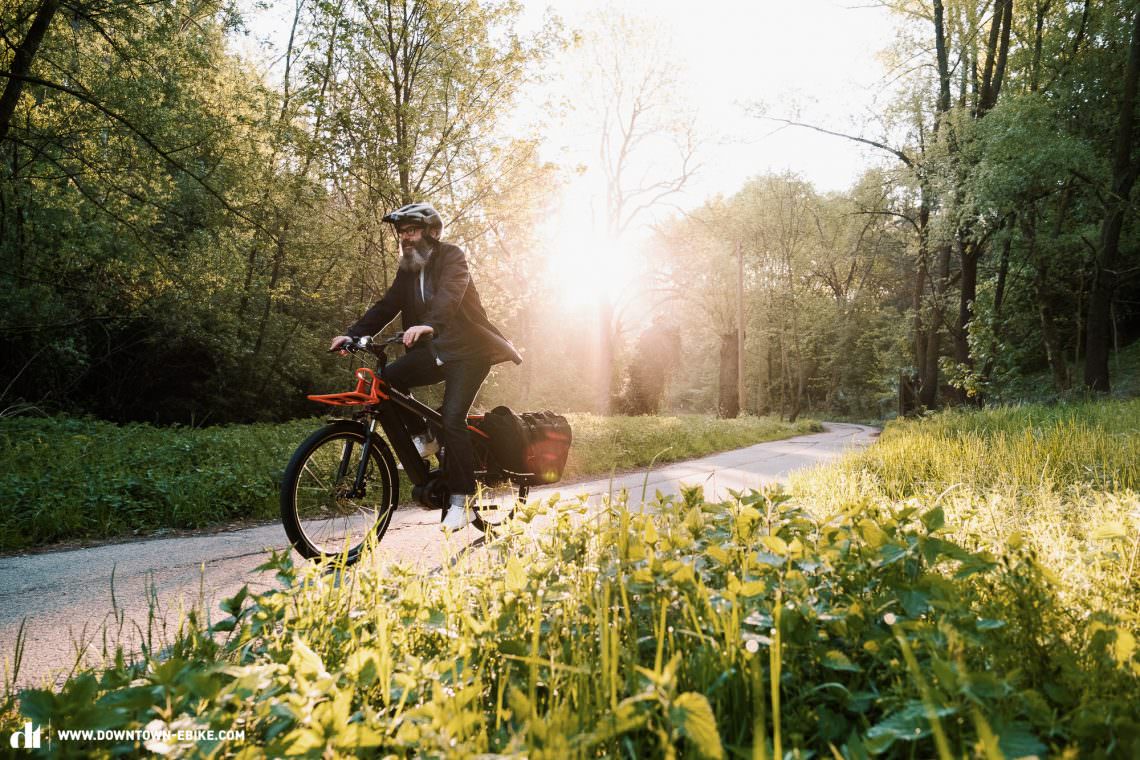
6. Range: how far can I ride my E-cargo bike with a full charge?
Unfortunately, we have to disappoint you: there is no simple answer to the question most commonly asked about ebikes. Before you head into the battery capacity arms race, you should think about what kind of battery concept is right for your individual requirements. How far do you ride and how much climbing do you do before the next charge? How many charging stations have you got and where are they (in your house or in the garage)? In other words, do you have to remove the battery for charging or can it remain in the cargo bike? The charging time also plays a role. You’ll find all the most important information about the different battery concepts in our sister magazine E-MOUNTAINBIKE, which is largely equivalent for E-cargo bikes. The only difference is that two or three kilograms of additional weight and the space required for an additional battery aren’t nearly as significant on a cargo bike as an eMTB. So, if you want to and can afford it, there’s no good argument against using a dual battery system. Depending on the manufacturer, stock dual battery options cost between € 700 and € 1,000 extra. Currently, Bosch are the only brand that offer an integrated dual battery option for cargo bikes, where both batteries are connected via a ‘Y’ cable. With a Shimano system, your only option is to carry a spare which you can swap out when the other battery is empty.
Getting back to our initial question concerning the range: besides temperature, payload, tire pressure, cadence and topography there are well over 20 variables that influence the range of your cargo bike. That’s why we can’t make any general statements about range and a laboratory test would be misleading since there is no way of replicating real-world conditions. Bosch’s range calculator offers a good starting point as it allows you to set countless parameters to give you an indication of how far you could get with your cargo bike.

7. The best cargo bike drivetrain: Shimano, SRAM, Enviolo or Rohloff SPEEDHUB?
When choosing the drivetrain, it is very important to consider where you use your cargo bike. In principle there are three relevant drivetrain options for cargo bikes: you have the classic Shimano or SRAM derailleur systems, the infinitely variable Enviolo hub gear (either manual or automatic) and the electronic Rohloff SPEEDHUB E14. All three concepts differ significantly in terms of their function, gear range, price and durability.
| Drivetrain | Type* | No. of gears | Gear ratio** | Max. torque |
|---|---|---|---|---|
| Enviolo Cargo 38 | H | infinitely variable | 380 % | 80 Nm |
| Enviolo N380 H-Sync (Automatic) | H | infinitely variable | 380 % | 100 Nm |
| Rohloff SPEEDHUB E-14 | H | 14 | 526 % | 130 Nm |
| Shimano XT-Schaltung 1×11, 11–46 t | D | 11 | 418 % | k.A. |
| Shimano XT-Schaltung 1×12, 10–51 t | D | 12 | 510 % | k.A. | SRAM GX Eagle 1×12, 10–52 t | D | 12 | 520 % | 120 Nm |
* H = Hub gear, D = Derailleur
** percentage difference between the lowest and highest gear
How many gears do I need? More importantly, how much gear range?
In general, it isn’t the number of gears that counts, but the gear range, i.e. the percentage difference between the lowest and highest gear. The interplay of motor, chainring and drivetrain is extremely important too since the motor is best able to deliver its full power at a certain cadence range. For heavy loads and steep climbs, you’ll need a correspondingly easy gear, which isn’t always available on the bikes with a drivetrain like the Enviolo Cargo 380 with a gear range of only 380%. While you’ll quickly reach the limits of this drivetrain’s capabilities in hilly cities such as Stuttgart or San Francisco, you’ll have no problems in flatter cities like Berlin or Amsterdam.
Generally speaking, the gearing of most cargo bikes in the test field is too high – what’s the use of pedalling at speeds of up to 40 km/h while riding downhill if you’re quickly brought to a halt on the climbs? This is why one of our most common tuning tips is to mount a smaller chainring. Your gear range will remain unaffected, but the overall gear ratio itself becomes lower, giving you easier gears overall. You’ll no longer be able to pedal at 40 km/h but it makes those nasty climbs all the more pleasant, especially for E-cargo bikes that only provide assistance up to 25 km/h, because we prefer to roll downhill anyway.
Hub gears or classic derailleur? Which should you choose?
Hub gears such as the Enviolo Cargo 380 or Rohloff SPEEDHUB E14 have a closed system that theoretically promises very low maintenance. They’re usually paired with a GATES belt drive instead of a chain, which is predestined for urban use since it doesn’t need to be lubricated, making it very low-maintenance and avoiding your trouser leg getting dirty. The big advantage of these drivetrains is that they allow you to shift while stationary, like at a traffic light, and you don’t have to ride as preemptively as you do with a derailleur that can only shift while you’re pedalling. Like an automatic gearbox in a car, the Enviolo N380 H-Sync drivetrain on the Butchers & Bicycles MK-1E automatically shifts gears to suit the riding situation and your desired cadence. This is less suitable for aggressive riders but beginners and more leisurely riders will both enjoy the automatic shifting!
During testing, we encountered a few problems and even total failures with hub gears. Wide range hub gears present a real engineering challenge. The planetary gear(s) have to be able to withstand extreme forces while the hub must be kept as narrow and compact as possible to fit into the rear wheel. Another disadvantage that you should keep in mind is that repairing hub gears is usually rather complex, usually done by a specialist and generally takes longer than repairing a derailleur.
Since you can’t shift with a derailleur while stationary, derailleurs require a pre-emptive riding style. High-quality derailleur systems like Shimano XT are around € 300 cheaper than an Enviolo hub or even € 1,500 cheaper than a Rohloff SPEEDHUB E14. Considering this, we’re happy to accept doing a little more maintenance. Depending on your riding style, the first wear-related service will be due after 1,500 km at the latest. The upside is that spare parts are readily available and repairs are the quickest, easiest and cheapest of all.
Again, there’s no general answer to the question of which drivetrain is the best but it all depends on your requirements and budget. Below, we’ve compiled a few tips to help you make the right decision.
Enviolo Cargo 380 and Enviolo N380 H-Sync hub gears
The infinitely variable Enviolo Cargo 380 with its pictographic display is self-explanatory and super easy to use. Shifting is mostly silent and doesn’t cause any problems even when stationary. Its major disadvantage is the gear range of only 380%, which is fine on flat terrain, but will quickly limit you when things get more hilly. The Enviolo Cargo 380 is designed for a continuous torque of up to 80 Nm, which, as experience showed us, isn’t enough. During our tests on the demanding climbs around Stuttgart, we encountered a few complete failures. Note: the Enviolo Cargo 380 should work just fine on flat terrain, even if it has a fairly high amount of internal friction and is significantly less efficient than a Shimano XT drivetrain. Compared to a Shimano XT drivetrain, you also have to fork out around € 300 more for the Enviolo Cargo 380.
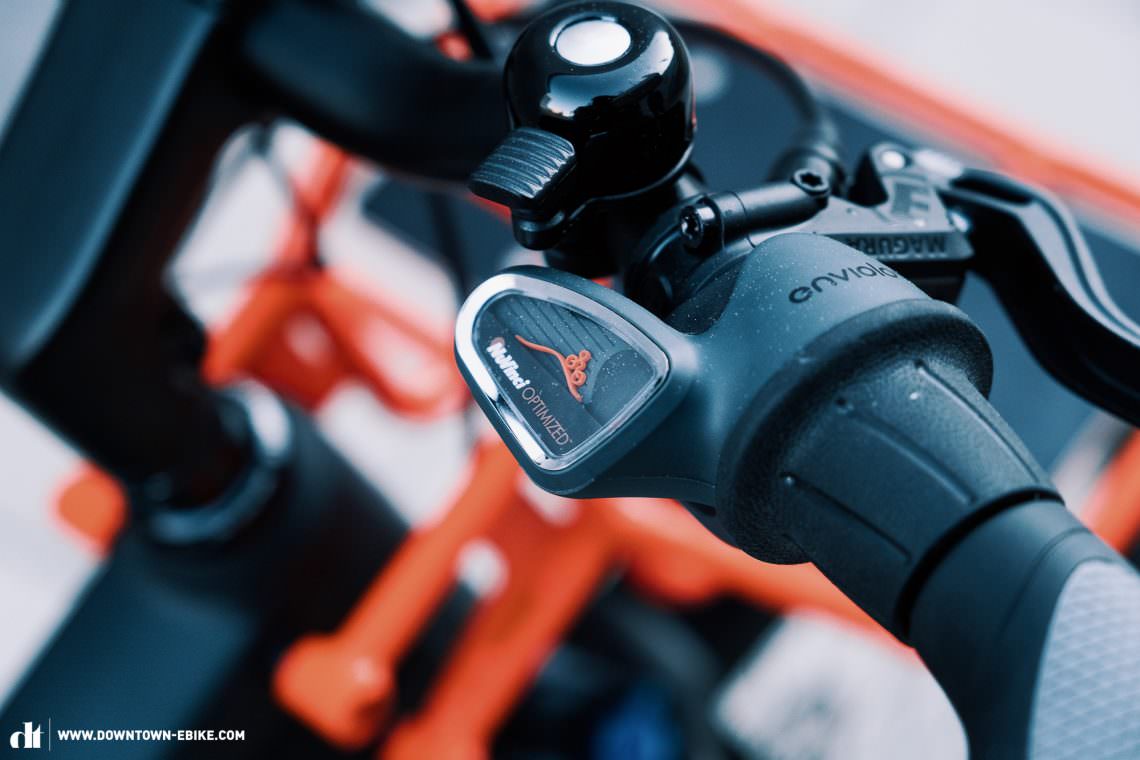
The N380 H-Sync is the automatic version of Enviolo’s hub gears, offering the same gear range and performance. Uniquely the drivetrain is connected to the control unit of the Bosch motor, so you don’t have to shift and there is no shifter on the handlebar. Depending on your cadence, the drivetrain shifts automatically to match the desired cadence set using the Bosch control unit. Beginners and more leisurely riders often forget to shift and end up being in a gear that is less than optimal for the motor. The automatic drivetrain helps you avoid making this mistake. However, the functionality of the Enviolo N380 H-Sync isn’t recommended for performance-oriented riders, as it restricts how dynamically you can ride the E-cargo bike. Due to the automatic cadence setting, the gear will often feel too easy when you pull away at a traffic light and want to put the power down on the pedals, the converse of which is that the cadence is too slow and the gear too difficult on the climbs. The same applies here as with the manual version: the Enviolo N380 H-Sync cannot cope with varying inclines or a larger dynamic range. However, it doesn’t have any problems on flat terrain and with a relaxed riding style. Compared to the manual Cargo 380 hub drivetrain, you have to budget around € 500 more.
Rohloff SPEEDHUB E14 hub drivetrain
The electronic Rohloff SPEEDHUB E14 isn’t included in this test field, but it is an option for the Load 60 in Riese & Müller’s online configurator as well as numerous other bikes. With 14 gears, a huge gear range of 526% and a maximum continuous load of 130 Nm, the SPEEDHUB E14 seems the ideal solution for cargo bikes. It also gives you the option of shifting while stationary. Apart from that, it recognises when you stop at a traffic light and automatically shifts to an easier, predefined gear to pull away in. However, this also comes at a price: compared to a Shimano XT drivetrain, it’ll set you back an additional € 1,500. Things that bothered us with this drivetrain during our first ride review of the R&M Load 60 in E-MOUNTAINBIKE Magazine and using it on various other commuter bikes are the delayed shifting compared to a derailleur, the loud gear changes, the lack of haptic feedback of the trigger and its durability.
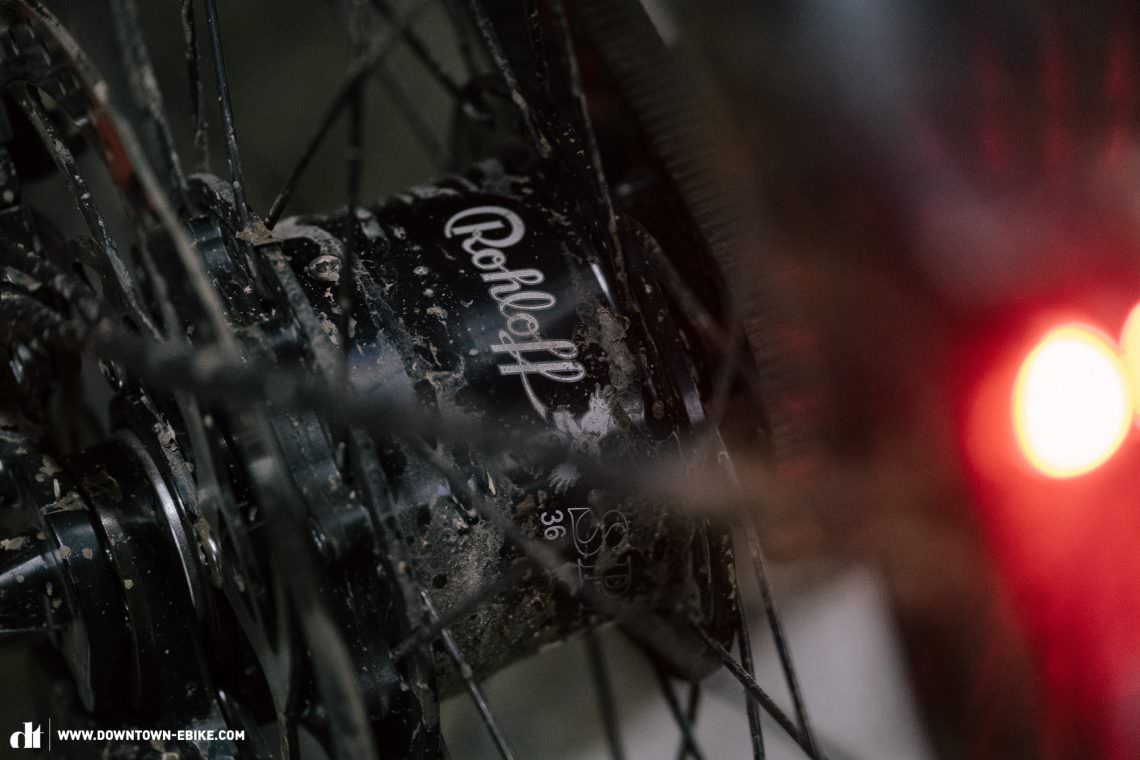
Shimano XT & co. – derailleur systems on cargo bikes
Aggressive riders with a preemptive riding style will get along well with a derailleur system. Depending on the model, the gear range is more than sufficient, though they can’t quite match the Rohloff. Drivetrains with a front derailleur and two or even three chainrings up front aren’t compatible with most mid-motor bikes and we wouldn’t recommend them in terms of function either. Our test experience has shown that classic derailleur drivetrains paired with powerful legs – or a powerful motor – are the most reliable option for hilly terrain, allowing for a dynamic riding style with super quick shifting. However, due to the heavily angled chain at either extreme of the cassette, you might encounter significant wear. Tip: if you only shift one gear at a time you can significantly reduce wear, and we also recommend keeping the chain well oiled.
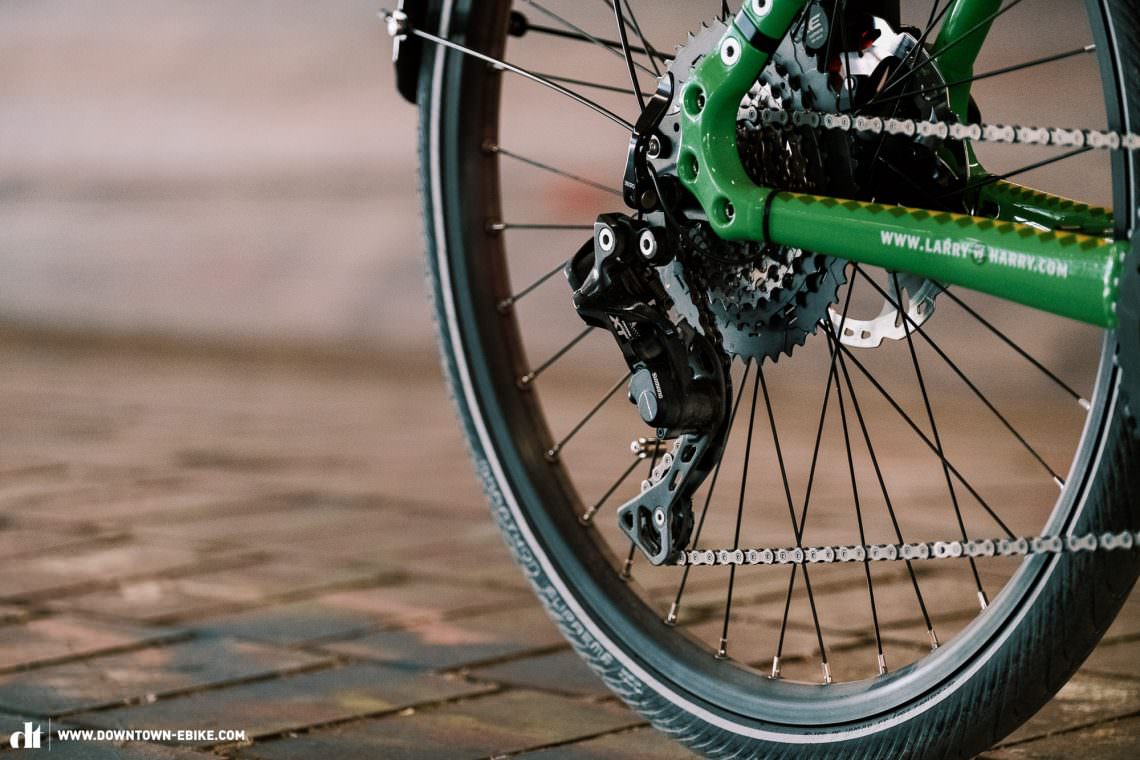
8. Everyday accessories: things you need for everyday cargo bike life
Regardless of whether you’re riding to the bakery, hardware store or navigating traffic jams, you need the right accessories for your daily adventures in the urban jungle. This means mudguards for rain or puddles and a powerful set of lights, ideally connected to the motor’s onboard battery and with a high- and low-beam function. By the way, brake lights, as legally required for s-pedelecs, would look good on every cargo bike!
It’s hard to believe but not all stands are equal. You want to be able to get the bike on its stand easily, where it should then provide a secure platform when loading the bike up, parking it in uneven terrain or when you have kids jumping on and off it. There are also huge differences regarding the noise the stand makes when folding it away. It might sound banal, but no one wants to be the centre of attention every time they get on their bike in front of the café or wake their neighbours on Saturday mornings when leaving to do some early shopping or to catch the sunrise.
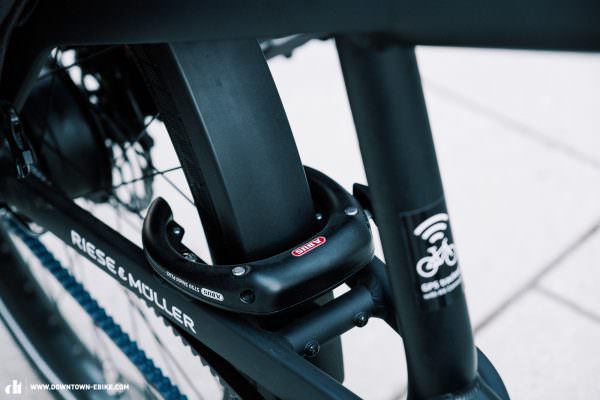
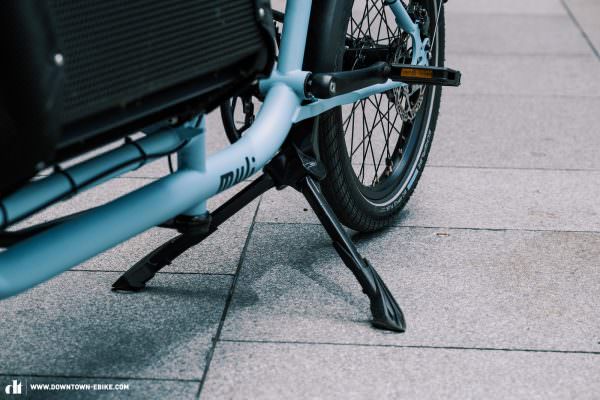
Of course, theft protection is extremely important too when you’re out and about in the city. Picking a safe place to park can help but we still recommend always carrying a mechanical anti-theft device in the form of a high-quality lock. Some manufacturers even include a special compartment for your bike lock on the outside of the loading bin. ABUS offer the option of using the same key for the lock and the battery: one key to rule them all. The good news is that thieves won’t easily be able to carry your cargo bike and, even though we still recommend it, you don’t necessarily have to lock your cargo bike to anything other than itself. Besides that, GPS trackers also provide added peace of mind.
If you park your bike fully loaded, you should of course also secure your cargo, made possible by some manufacturers thanks to lockable transport boxes or covers.
Last but not least, no one should ride a cargo bike without a decent bell, so you can draw attention to yourself and also prevent pedestrians from getting a fright if you sneak up on them from behind. All s-pedelec E-cargo bikes are equipped with a horn as standard. However, the sound of a bell turns out to be a lot more friendly in certain situations.
9. “Darling, how much should I pack?” – the maximum permissible weight limit
Just like the gross vehicle mass (GVM) of a car, bicycles have a maximum permissible weight limit. The weight limit is specified by the bicycle manufacturer and ensures that all the bike’s components are able to cope with the load. The maximum permissible weight is always determined by the weakest component. It includes the weight of the bike, the rider, all their gear (helmet, backpack, etc.) and the cargo.
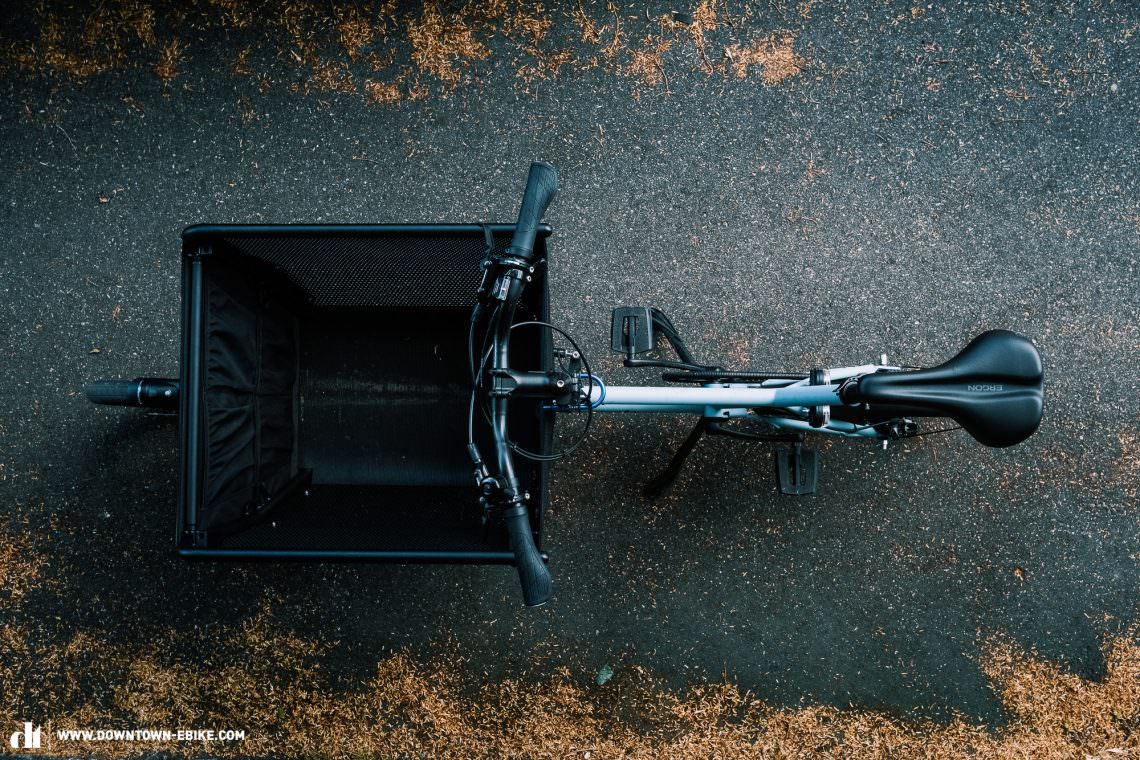
To work out the maximum payload, which is what’s left for the rider, their gear and their cargo, you simply subtract the weight of the bike, up to 50 kg in this case, from the maximum permissible weight limit. An aspect unique to cargo bikes is the loading bay. Usually, manufacturers only certify the loading bay up to a certain weight, so you have to divide the maximum payload of the entire bike between the payload of the loading bay or rear carrier and the payload of the rider. Unfortunately, not all manufacturers communicate this very clearly, simply giving a maximum permissible weight limit for the bike. Things can become confusing if the manufacturer provides several data points on the maximum permissible weight, including the maximum payload of the carrier and the maximum payload for the rider. As a general rule of thumb, all you have to remember is that you’re not allowed to exceed any of the limits. The lowest cargo weight limit (excluding the rider) of the longtail bikes on test is 65 kg and the lowest cargo weight limit of the long john bikes on test is 70 kg. If you’re thinking of cruising through the city with loads of up to 100 kg, we recommend paying careful attention here.
| Bike | Weight | Perm. total weight | max. payload (rider) | max. payload (cargo) |
|---|---|---|---|---|
| Bergamont E-Cargoville LJ 70 | 45.9 kg | 220 kg | 84 kg | 90 kg |
| Butchers & Bicycles Mk1-E Automatic | 51.3 kg | 250 kg | 120 kg | 80 kg |
| Croozer Cargo Tuure | 10.6 kg | 60 kg | – | 45 kg |
| Larry vs Harry STePS eBullitt E8000 XT Di2 | 36.6 kg | 217 kg | 180 kg | n/a |
| Muli-Cycles Muli Muskel | 27.4 kg | 197 kg | 100 kg | 70 kg |
| Riese & Müller Load 60 Touring GX | 45.5 kg | 200 kg | 115 kg | 100 kg |
| Riese & Müller Multicharger GT Vario | 38.2 kg | 175 kg | 136 kg | 65 kg |
| Tern GSD S00 (Click for review) |
42.8 kg | 200 kg | 120 kg | n/a |
| Urban Arrow Family Performance CX Disc Zee 500 Wh (Click for review) |
52.0 kg | 275 kg | 125 kg | n/a |
10. The best E-cargo bike display: minimalistic or command centre with navigation and security features?
Do you like having onboard navigation as you cruise through the city or the woods with your cargo bike, want to listen to music, have an emergency call function and crash detection as a safety feature and always have the most important riding data clearly displayed? Then what could be better than your smartphone? The COBI.Bike app for the Bosch SmartphoneHub is the best-integrated solution currently out there, which is also available as an aftermarket upgrade for the price of € 230. It also allows you to charge your smartphone via the bike’s integrated battery. The Shimano displays and Bosch’s Kiox, Intuvia or Purion displays all show the most crucial riding data but that’s it. You could resort to using an aftermarket smartphone mount and most ebike displays have a USB port to plug your phone in for charging. Our favourite app for route planning and navigation is Komoot. Shimano offer the cleanest display integration, but they only provide you with basic data. If you want to navigate, you’ll have to use a dedicated GPS device or your smartphone.
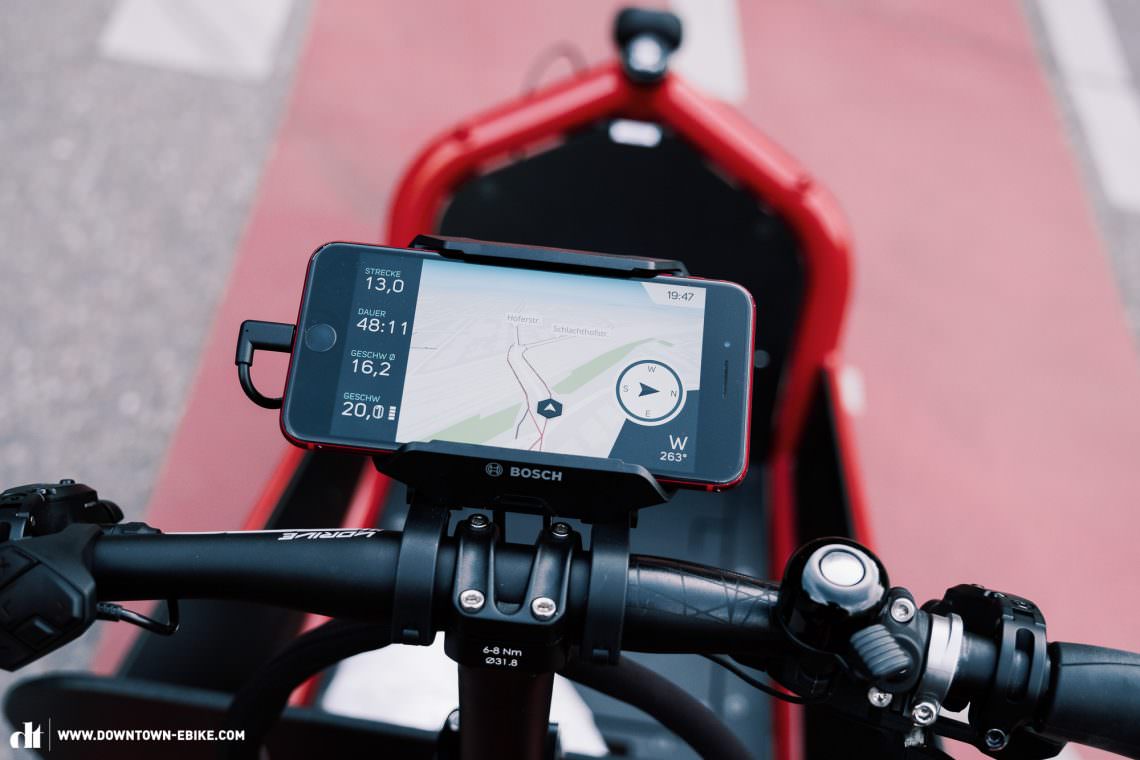
5: Which is the right cargo bike for me?
You can only find the right cargo bike once you’ve figured out what you plan to use it for and what your personal requirements are. In this chapter, we’ll give you an overview of the respective character and optimal use of the cargo bikes we tested, as well as tips on how to find the right bike for you!



Build your own cargo bike!
Most brands have an online configurator with numerous components, accessories and customisation options to choose from! This ranges from the frame colour to the drivetrain (very important!), boards for the loading bay, additional luggage racks, child seats, transport boxes, weather protection and lights all the way to GPS trackers, displays and battery options. Urban Arrow even offer different motor options. We tested the Urban Arrow Family with the previous generation Bosch Performance CX motor but we’d recommend spending € 400 more for the Bosch Cargo Line motor. Bike fanatics can let their dreams run wild with the endless configuration options available from Bullitt. Tern, Riese & Müller and Butchers & Bicycles also offer numerous stock options.
So, don’t settle for the dusty bike in the shop and make use of the customisation options that brands make available to you, while remembering our 10 most important tips from chapter 4! If you already own an ebike or an eMTB (that’s certified to pull a trailer), a trailer might also be an option worth considering. While it doesn’t give you the same feeling, it’s an inexpensive option with lots of flexibility.
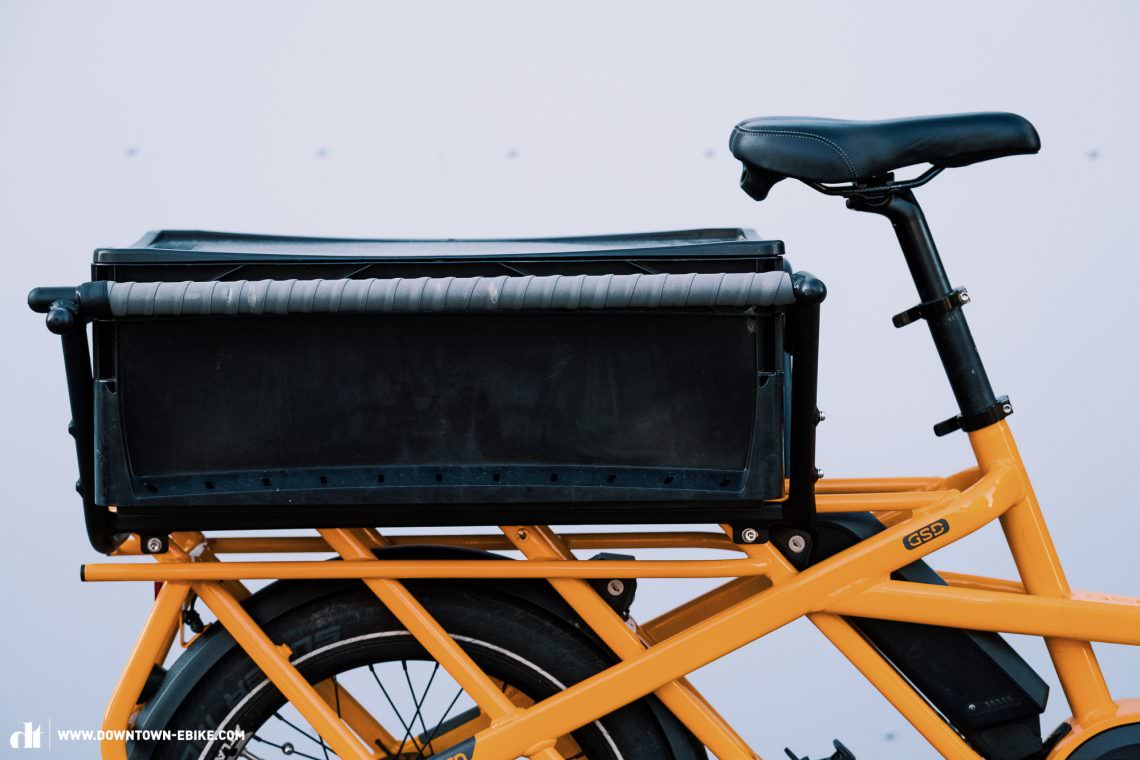
Modular, variable design = versatile cargo bike
Some cargo bikes are specialists while others are generalists. If you’re going to share your cargo bike with several people or if you want to use your cargo bike to bring the kids to daycare in the morning and fetch cement at the hardware store in the afternoon, you’ll want your cargo bike to be as versatile as possible. Thanks to quick and simple, tool-free conversion options, such as adjustable quick release stem or a modular loading bay, you shouldn’t have any problems.
Below, we’ve compiled a few concrete examples of what to look for on a cargo bike intended for a specific application:
Shopping
compartmentalised storage space is important, otherwise the ravioli, rocket, parmesan and organic eggs will fly around and you’ll have made a salad before you even start making dinner. We also recommend a lockable cover if you’re going to make several stops and have to leave the bike outside with your shopping.


Commuting to the office
lights for early or long days in the office, storage space for a laptop and other essentials, fenders and a lockable soft top. If you want to use your cargo bike with other means of transport like the train, you should choose a light and compact cargo bike like the Muli, Tern or R&M Multicharger Vario. They’re still big enough for your wheely case and suit bag!

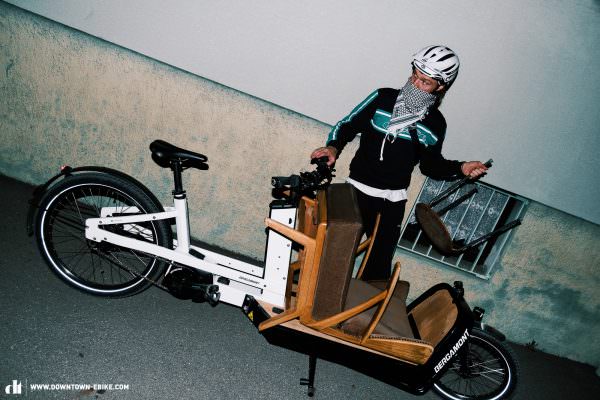
Bulky luggage
If you have bigger plans, you should go for a long john cargo bike with a low-slung cargo bay. You’ll be surprised how much these can transport. Long john cargo bikes are particularly convenient if you’re planning to get yourself some new furniture – you’ll get more on a cargo bike than in a Porsche 911 or a Volvo V70. Our clear favourites are the Bergamont and eBullitt with their deep and flat loading decks.
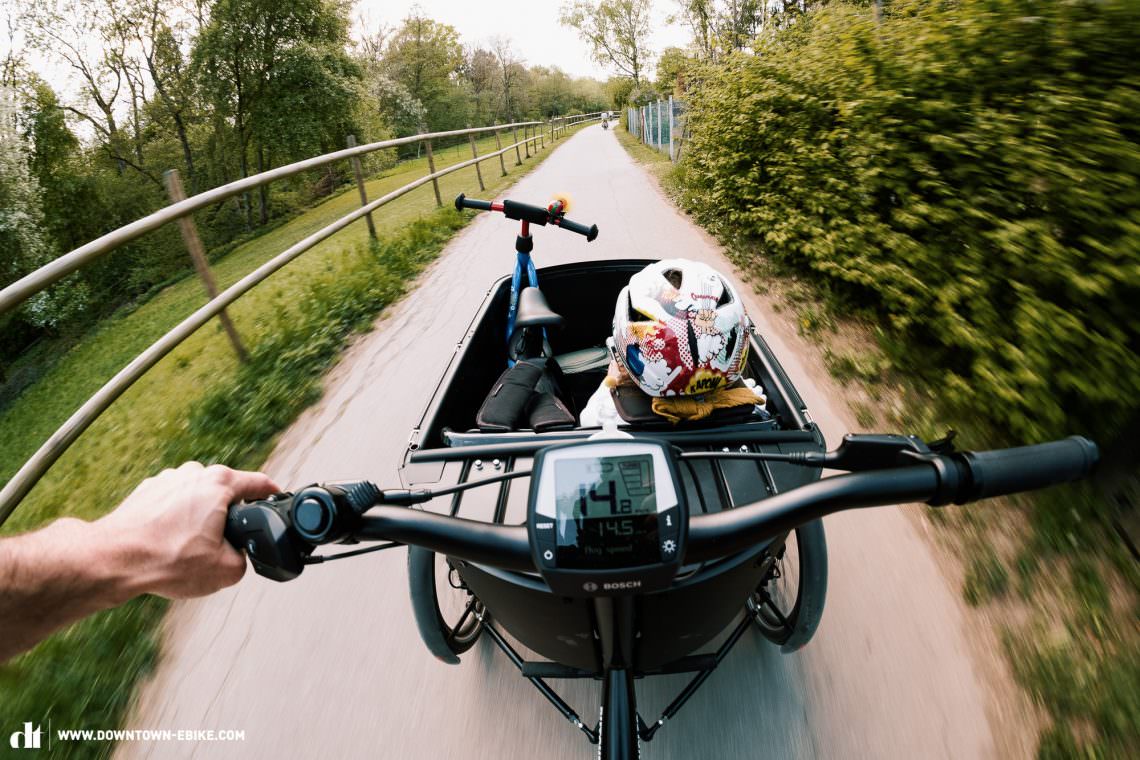
Family, kids & pets
Depending on how old your kids are and how long they can keep still, you’ll have better or worse cargo bike options. If you want to put your kids on the back, your youngsters should be at least 2 years old and be able to hold on. There’s no upper limit on age and depending on the maximum payload of the rear carrier, you could also transport adults, though not with the child seats and belts. Putting your kids up front has the advantage that you can always keep an eye on them. In this case, safe and easily adjustable straps are just as important as comfort, ideally in the form of a full suspension chassis as found on the Riese & Müller Load 60. The eBullitt is the complete opposite of this with its super stiff frame. You could easily transport your kids with the appropriate seat and safety belts, but whether you want to inflict that kind of punishment on their fragile bones is another question. We encountered a few hair raising moments when braking with the Butchers & Bicycles trike due to its poor weight distribution. Too bad, because the deep transport box, which is optionally available with a door for easier entry, never had our test dogs, Leo and Henry, thinking about jumping ship when things got a little bumpy. Whether you’re transporting your kids or pets, you’ll also want a separate, ideally lockable storage compartment for smaller personal belongings such as your wallet, keys and phone! By the way, you also get transport boxes and trailers made specifically for dogs, such as the Croozer Jokke.

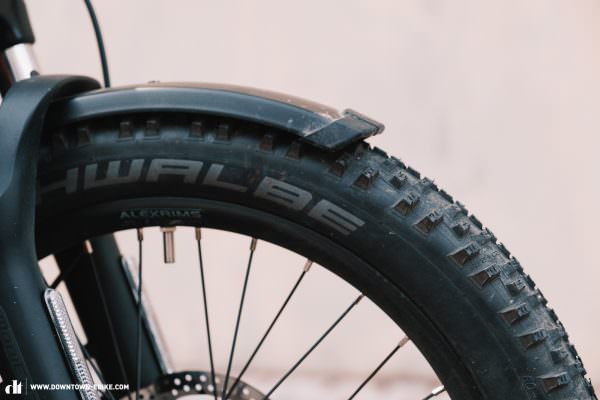
Gone astray, but still on the right path!
If you want to head into the countryside every now and then, explore gravel roads or unpaved paths to find the perfect picnic spot or hunting grounds, or go get firewood, there’s nothing better than a cargo bike. The GX version of the full suspension Riese & Müller Load 60 isn’t only perfect for urban adventures but also has a unique set of off-road skills. With this bike you can rediscover your surroundings and maybe a little bit more of the world, as DOWNTOWN publisher Robin found when it was time to say goodbye to his Jeep Cherokee!
Since you’ll often have more than one use for your cargo bike, you should also weigh up your priorities, check what accessories are available and, if necessary, make sure that the loading bay is quick and easy to convert to multiple purposes.
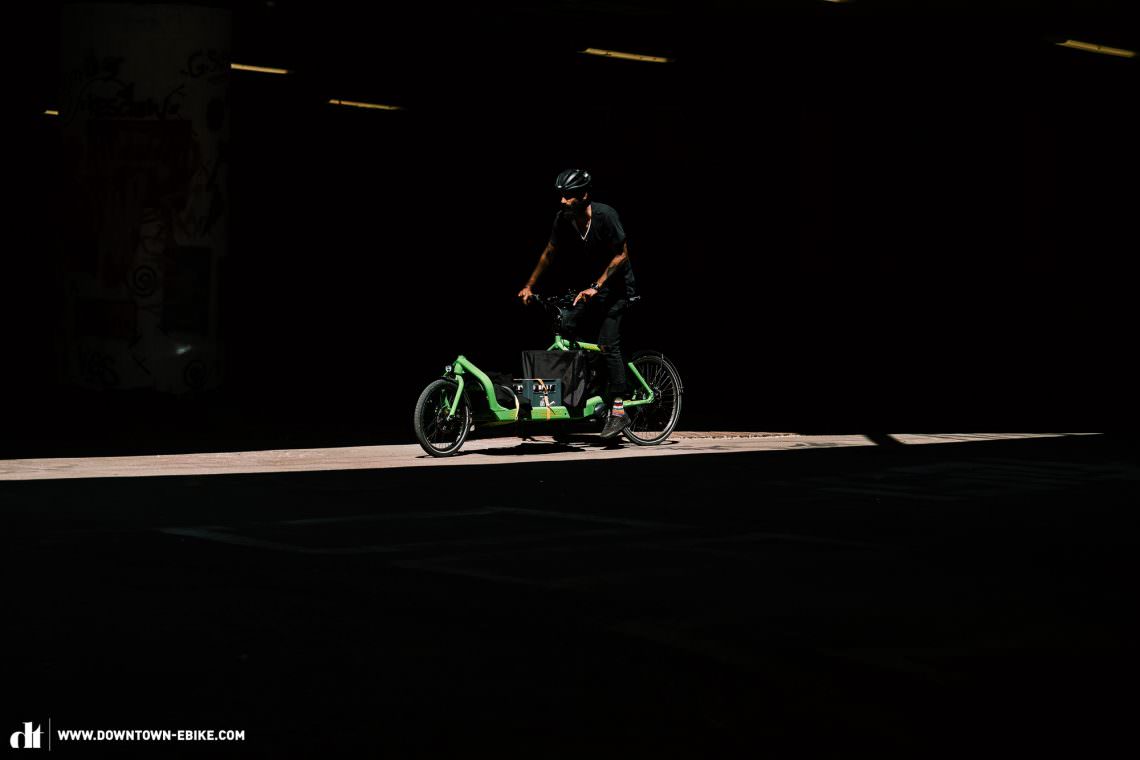
What frame size is right for my cargo bike?
None! Oddly enough, all of the cargo bikes we tested are available in just one frame size and depending on the model, you’ll be able to adjust the fit more or less. We recommend inquiring about the manufacturer’s recommended minimum and maximum size and to ensure that you get high-quality adjustable components (such as a stem that allows you to adjust the angle and height) or that the bike shop adjusts everything correctly for you.
Money for the honey: buy smart with cargo bike incentives
There is no question, E-cargo bikes are a big investment for most of us. If you pay attention to a few important things when you buy, you’ll be able to save yourself a few thousand euros by choosing the right financing option and cargo bike incentives.
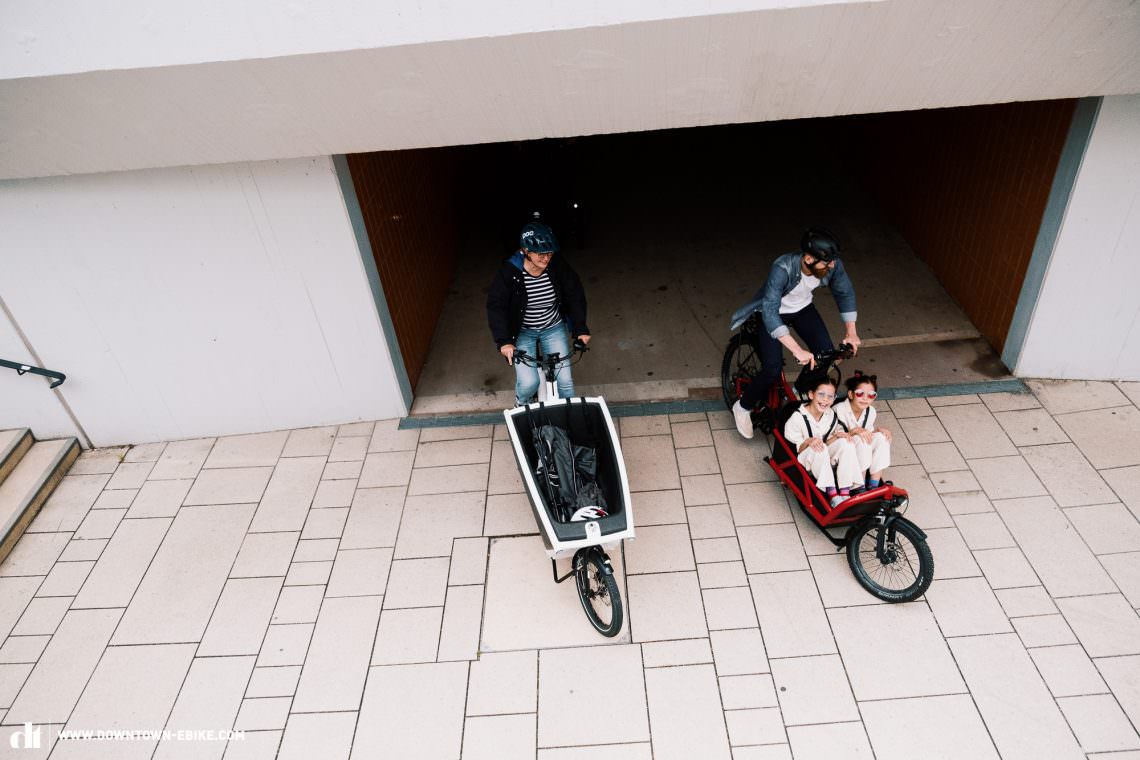
6. Which is the best E-cargo bike 2020? Tops & flops, Best in Test, Best Buys and the losers
It’s a sensation! Even if biologists all over the world agree that the egg-laying, milk-producing, woolly sow is a mythical creature, we have to disagree. It exists. At least in the world of cargo bikes. But let’s not get ahead of ourselves.
Even if the individual requirements of cargo bikes are highly specific and varied, our wide-ranging group test has clear winners and losers. It’s often the small details such as cleverly specced components, good integration, pragmatic solutions and excellent workmanship that make all the difference. However, sometimes it comes down to the basic features and properties, such as the construction of the frame, innovative connectivity and weight distribution. We’ve made a list of all the tops and flops from our big cargo bike group test.
Tops
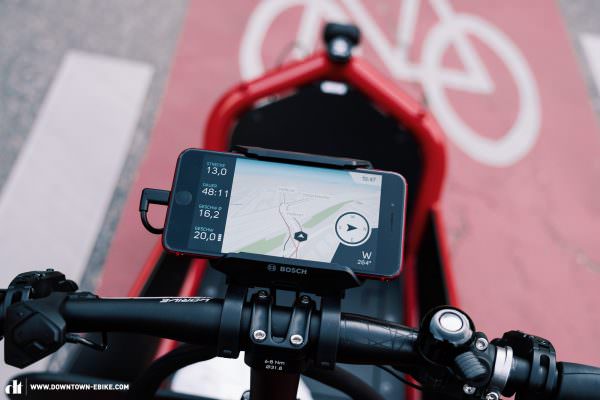
Combined with your smartphone and the appropriate app, the Bosch SmartphoneHub turns your bike into an intelligent control centre for navigation, music and fitness tracking.
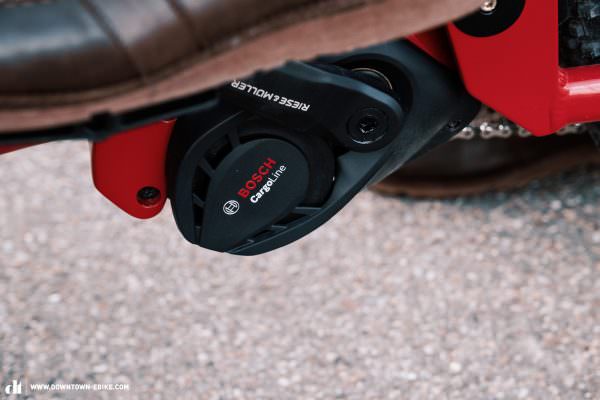
The Bosch Cargo Line Cruise is the most powerful yet easily controllable motor in the test.

The cargo box of the Muli can be folded up and out of the way within two seconds, making it super compact.

The Riese & Müller and the eBullitt cargo bike both come with lights offering a low and high-beam function, so you’ll never get caught in the dark.

The optional RX Connect security concept from Riese & Müller offers tracking in the event of theft and other services such as insurance, recovery and vehicle replacement.

Who doesn’t like going out into the countryside for a barbecue or picnic or to take the shortcut through the woods on gravel roads? With off-road tires like on the R&M Load 60, there’s nothing stopping you!
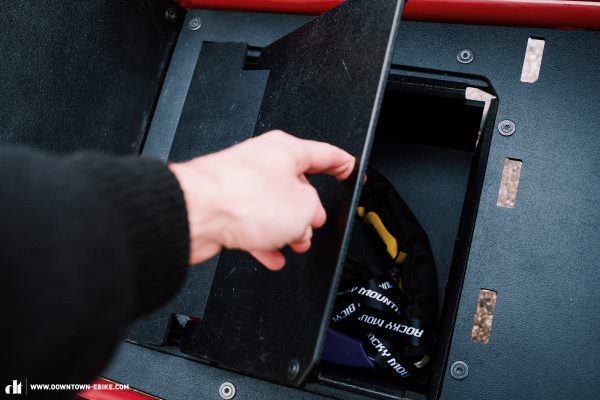
Whether as a way to get your feet lower or as additional storage space for snacks, tools or a lock, the small compartments in the R&M Load 60 and the Butchers & Bicycles are super practical.
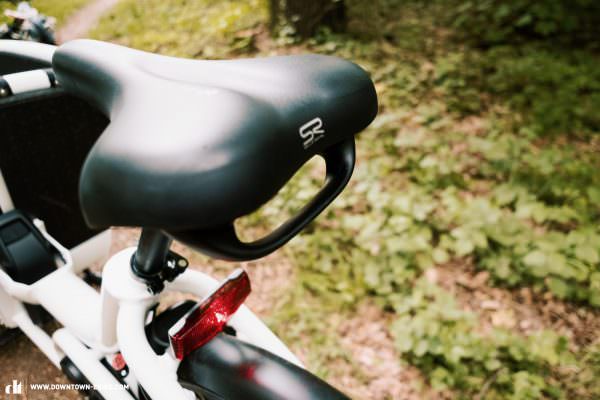
The handle on the saddle makes it much easier to manoeuvre the bike while stationary. It should be a standard feature on every long john cargo bike!
Flops
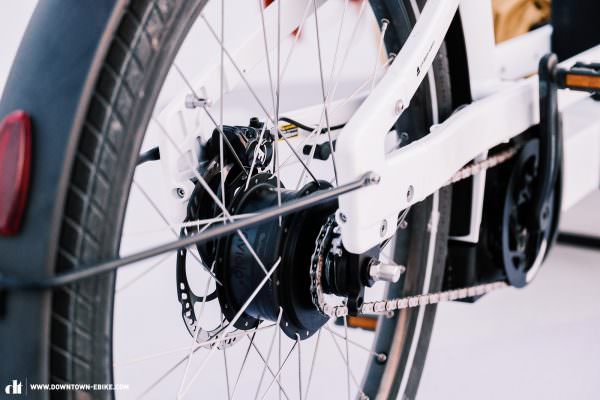
The Enviolo Cargo drivetrain is a bit stingy with its 380% gear range, which isn’t enough for steep climbs. During the test, we encountered a few issues regarding durability and even had total failures!
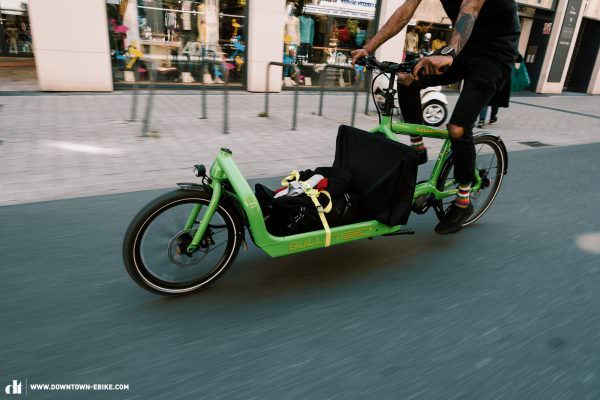
The frame of the eBullitt is extremely stiff and too uncomfortable for transporting kids.
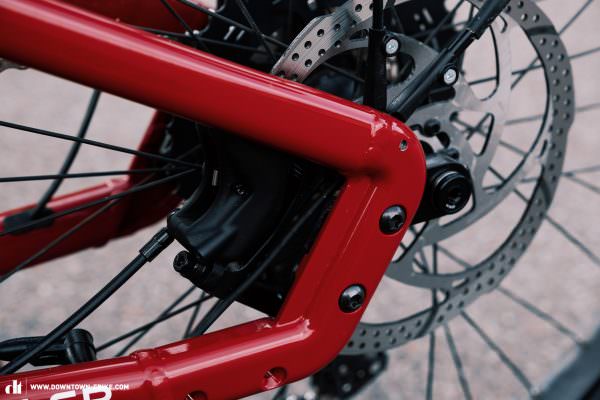
When fully loaded, the two-piston brakes on the R&M cargo bikes aren’t on par with the competition and quickly reach their limits.
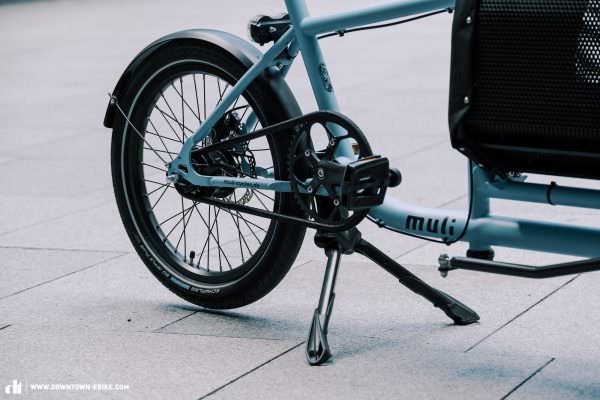
A lot of cargo bikes in the test field came fitted with chainrings that were too big for steep climbs, such as the Muli with its huge 50 t pizza.
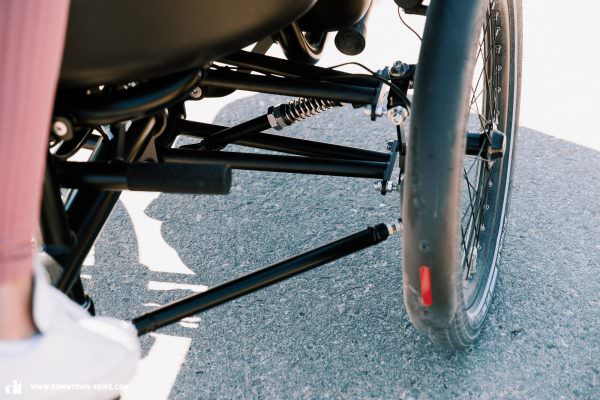
The tilting mechanism in combination with the weight distribution on the Butchers & Bicycles Mk1-E Automatic takes more than getting used to, making for nervous handling and some hair raising moments. Who came up with this?

The second battery on the eBullitt isn’t connected and can’t be locked, making it vulnerable to theft.
The winners
Riese & Müller Load 60 Touring GX
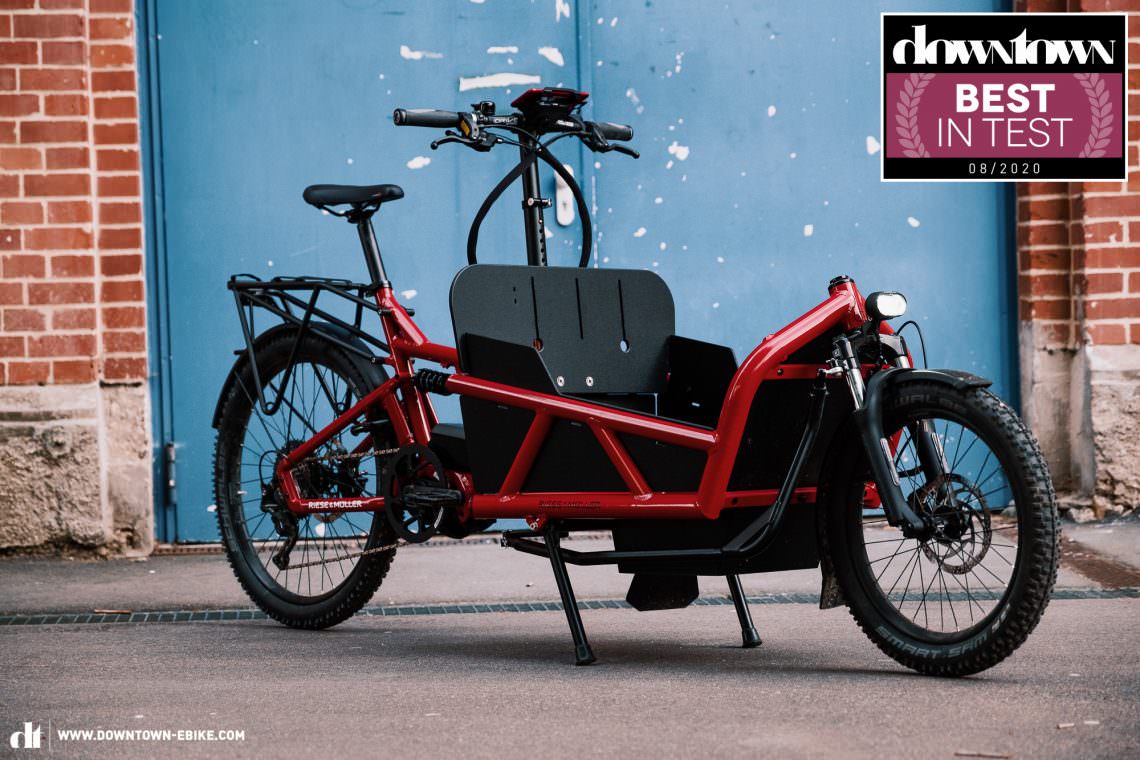
The Riese & Müller Load 60 Touring GX (click here for the full review) plays in a league of its own, delivering the best overall package in terms of stability, comfort, everyday accessories, versatility, connectivity, motor performance and battery concept. Riese & Müller’s € 7,858 Load 60 Touring GX E-cargo bike is the ultimate all-purpose companion for everyday urban life, transporting kids and trips into the countryside! Thanks to the full suspension chassis, optional GPS tracking, GX off-road tires and intuitive handling, this E-cargo bike offers maximum safety and comfort as well as being the most versatile option in the group test. It is the only truly off-road capable bike and therefore perfect for barbecues and campfires out in nature. The powerful Bosch Cargo Line motor and the Bosch SmartphoneHub also set the benchmark. The coherent concept, offering innovative features, adaptability and a wide range of accessories, ultimately ensures a unanimous Best in Test! If you’ve been questioning whether you can have everything you need rolled into one package, here is the proof!
Bergamont E-Cargoville LJ 70
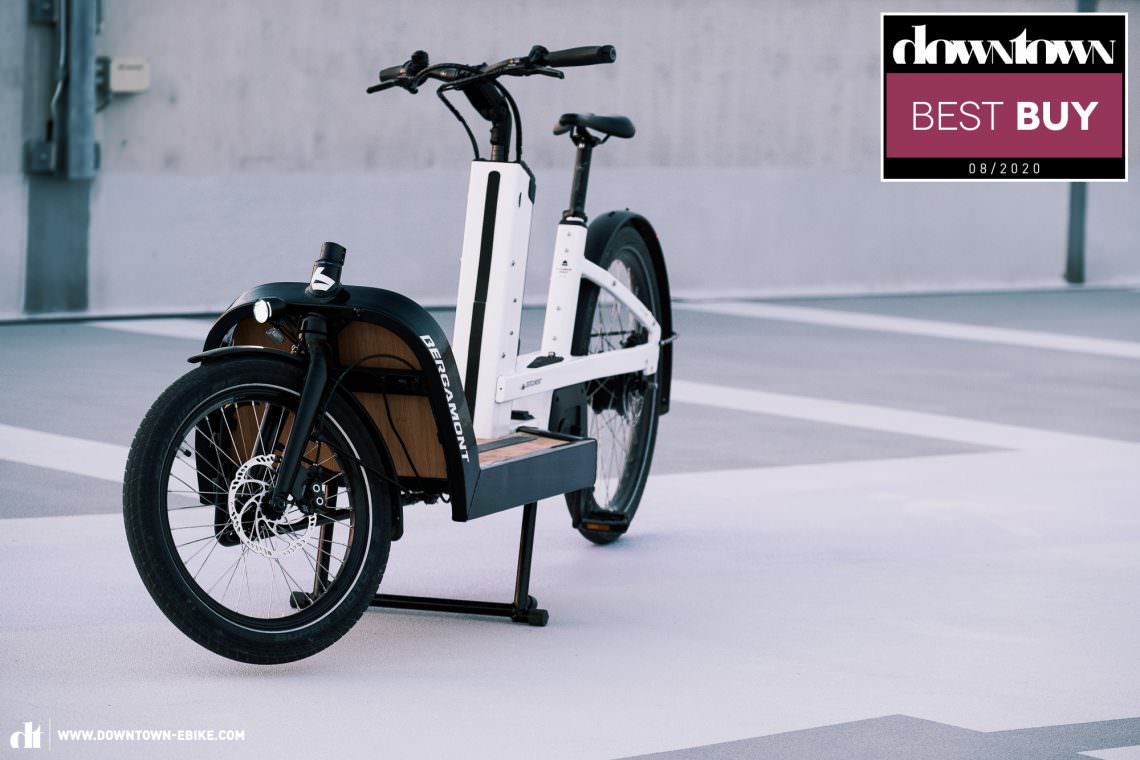
With its super intuitive handling, rock solid construction and stylish looks, the € 5,399 Bergamont E-Cargoville LJ 70 (click here for the full review) is our well-deserved Best Buy. The easy to control assistance of the powerful Bosch Cargo Line motor matches the dynamic and predictable handling of this German bike. Unfortunately, the capability of the Bergamont is limited in mountainous regions due to the small range of the Enviolo drivetrain. However, you’ll be in good hands if you live in a flat city like Amsterdam!
Larry vs Harry STePS eBullitt

The direct and precise handling of the high-quality Larry vs Harry STePS eBullitt (click here for the full review) with its stiff frame and Shimano STEPS E8000 motor is perfect for sporty and experienced riders. Unfortunately, this cargo bike is too stiff to comfortably transport kids. You should also think twice before riding off a curb. You can customise the eBullitt via the online configurator, where you’ll also find a huge selection of third-party accessories.
Muli Muskel-Cargo-Bike
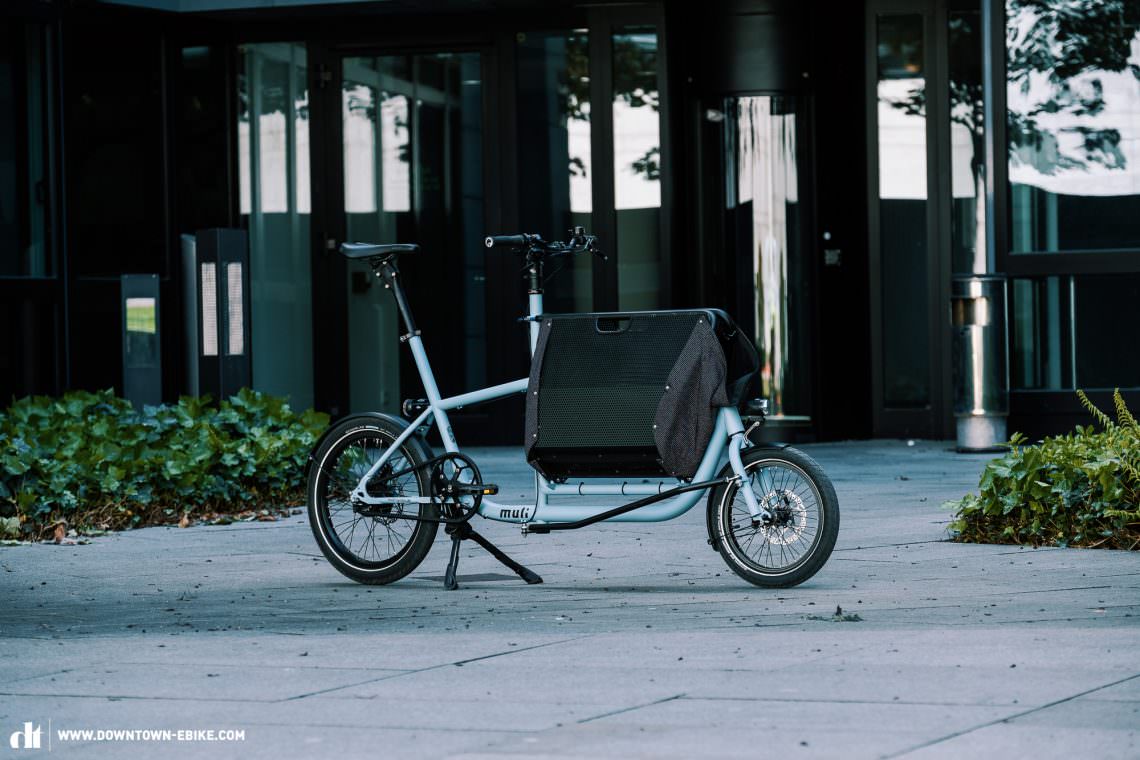
Tired of motors and electronics and think your legs are strong enough? Then the keenly priced €3,045 Muli Muskel-Cargo-Bike (click here for the full review) is the perfect choice, offering a coherently minimalistic package! This lively speedster is best suited to flat terrain, offering fun handling for experienced riders. You can even carry it into your basement with the basket folded up.
Neutral – definitely not a bad choice!
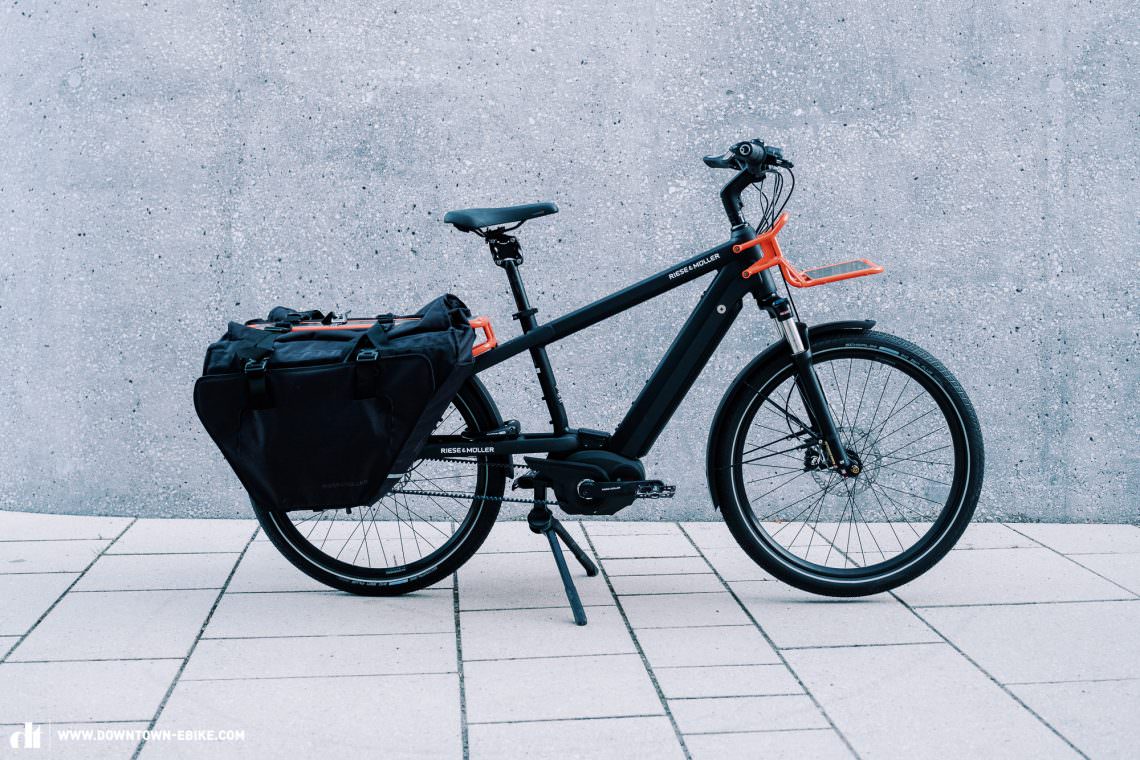
The Riese & Müller Multicharger is two bikes in one: a trekking bike with stable handling and a versatile cargo bike! It delivers a convincing performance when commuting, on family trips and on moderate off-road terrain while coping just as well with photography equipment, shopping or kids on the rear rack. However, in terms of fun, carrying capacity and ride feel, baker’s bikes can’t compare with the long johns. We were also less convinced of the quality of the luggage rack system on the Multicharger.

The Tern GSD S00-E-Cargo-Bike is the perfect pack mule for small and heavy loads or to take your kids to the kindergarten when they’re a bit older. However, it isn’t as suitable for trekking and weekend excursions as the R&M Multicharger. The same applies to steep climbs. Thanks to its compact dimensions and the possibility of storing it vertically, it’s a good option for the urban jungle where space is limited. Its diminutive form also contributes to its agile handling!
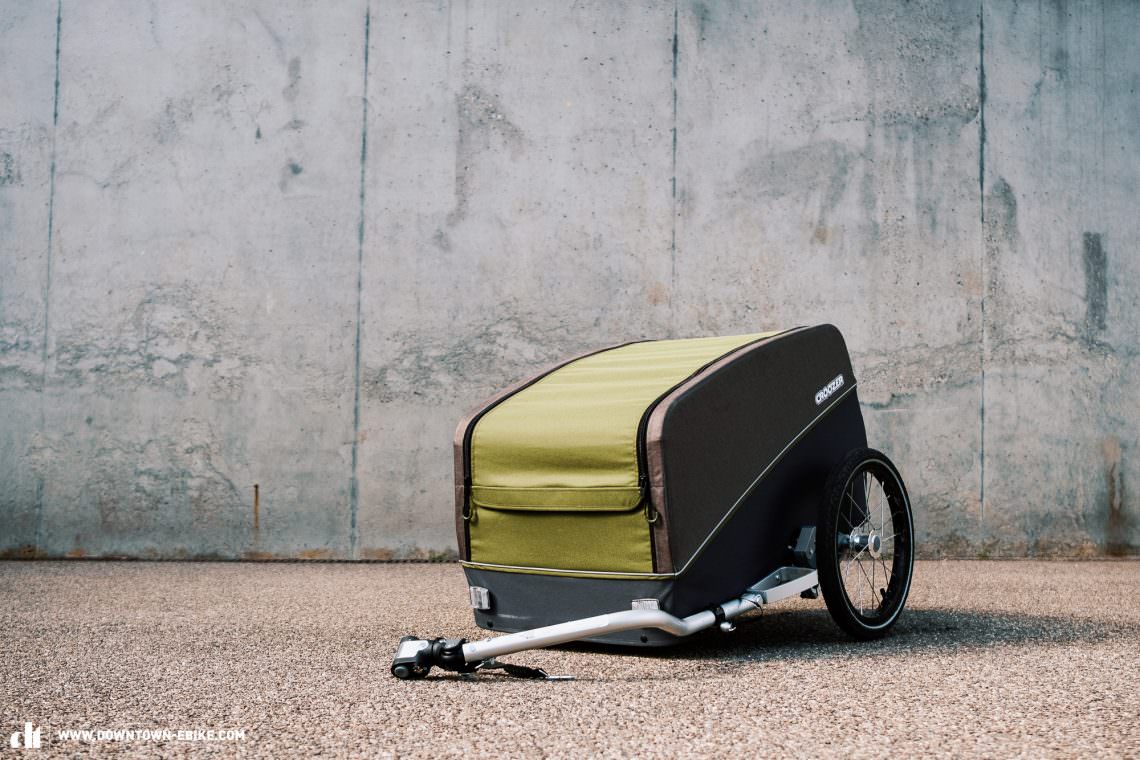
Square, practical and good – convenient, though not sexy, a trailer is a serious and cost-effective cargo option that allows you to convert your existing bike (if certified to pull a trailer). Going shopping and want to drag your dog along? The Croozer Jokke and Croozer Cargo Tuure models convinced us with their suspension and convenient trolley accessories. It’s the rational, if not most exciting choice!
The loser – sexy yet complicated!
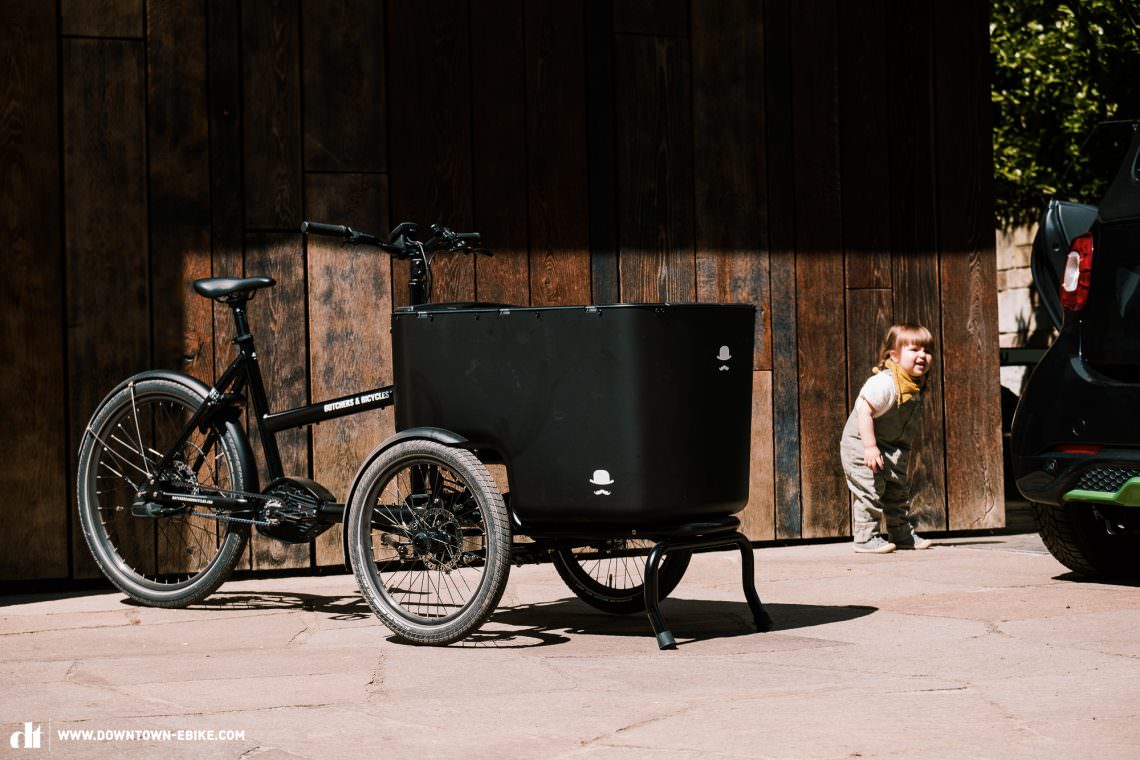
The Butchers & Bicycles Mk1-E Automatic leaves us with mixed feelings. On the one hand, we love its Scandinavian style and huge transport box. On the other, getting used to the handling takes quite a while and even then it requires a lot of physical input from the rider and occasionally poses a safety risk to you and your passengers. It is not made for newbies or for people with an aggressive riding style and at € 7,626 you get a lot of technology, but little performance. What a shame!
Congratulations, if you’ve read and processed the previous 25 pages, then you’re qualified to call yourself a cargo bike expert. We hope that the extensive information we’ve given you here has helped you draw a comprehensive picture. As you can see, we’re not satisfied with simple answers but try to convey the complex reality and individual requirements as clearly as we can, to help you make the most informed choice possible.
All bikes in test
Bergamont E-Cargoville LJ 70 (Click for review) | Butchers & Bicycles Mk1-E Automatic (Click for review) | Larry vs Harry STePS eBullitt E8000 XT Di2 (Click for review) | Muli-Cycles Muli Muskel (Click for review) | Riese & Müller Load 60 Touring GX (Click for review) | Riese & Müller Multicharger GT Vario (Click for review) | Tern GSD S00 (Click for review) | Urban Arrow Family Performance CX Disc Zee 500 Wh (Click for review) | Croozer Cargo Tuure (Click for review)
Words: Robin Schmitt, Philipp Schwab, Jonas Müssig, Benjamin Topf, Felix Stix Photos: Benjamin Topf, Robin Schmitt, Valentin Rühl, Marius Burghard (illustrations)




